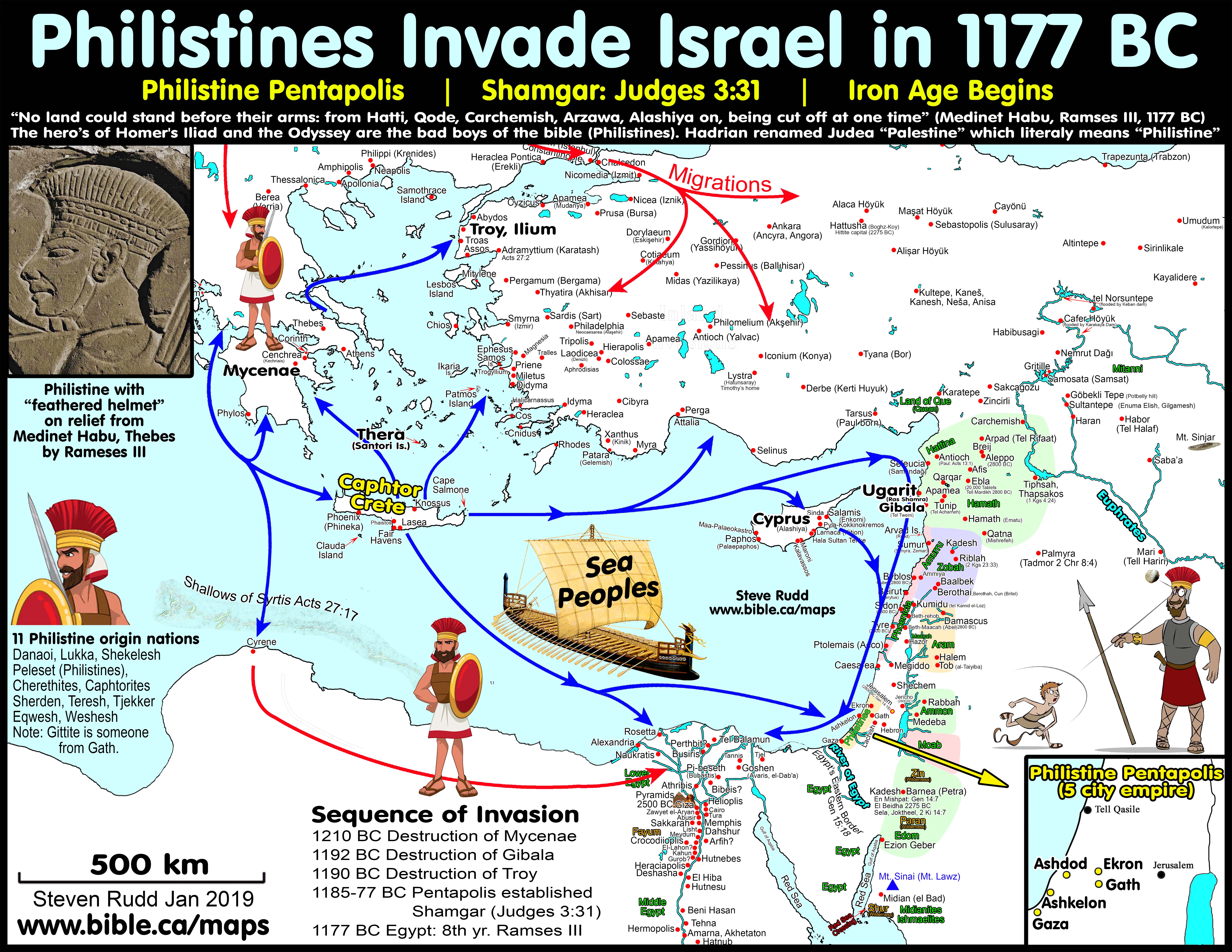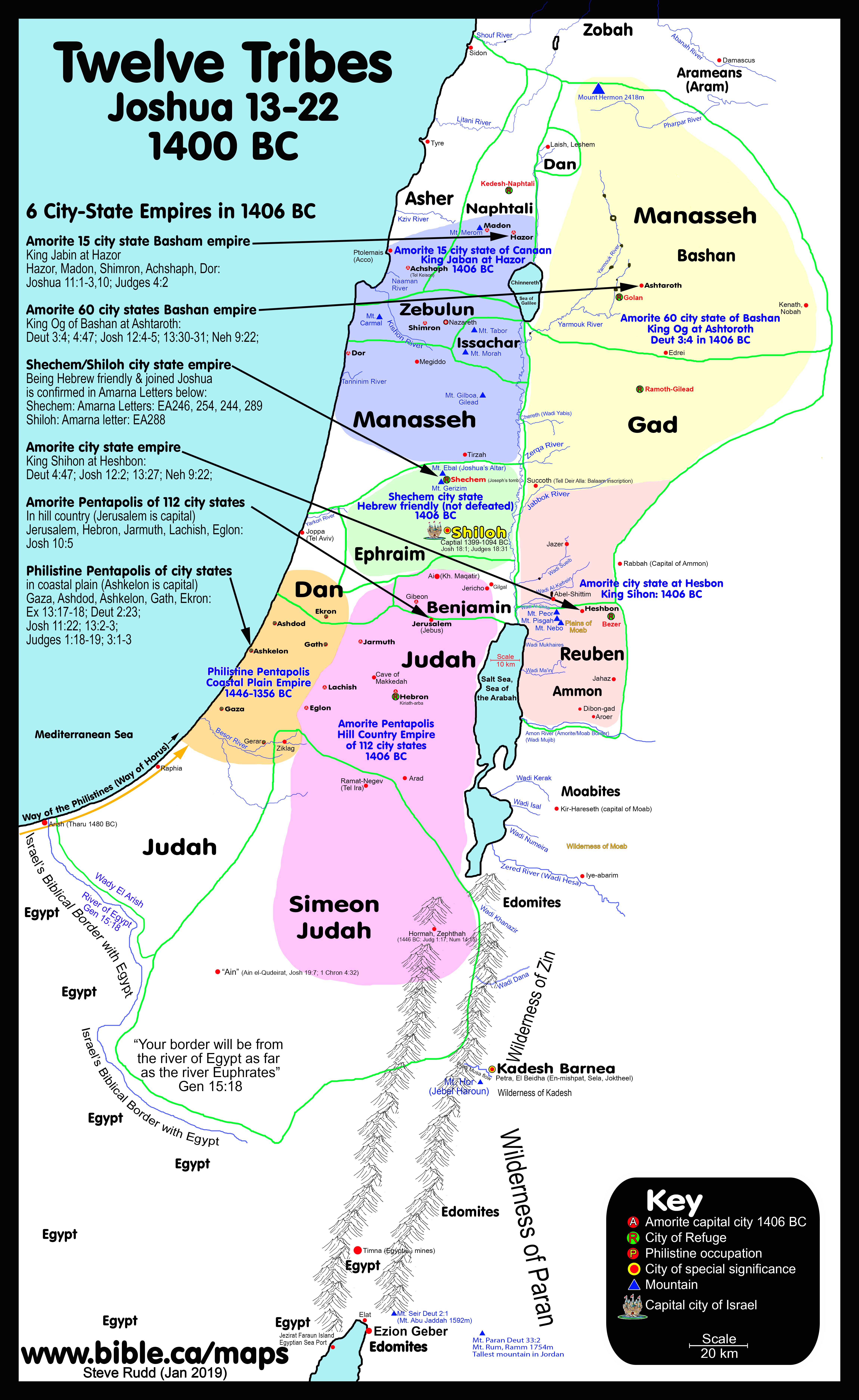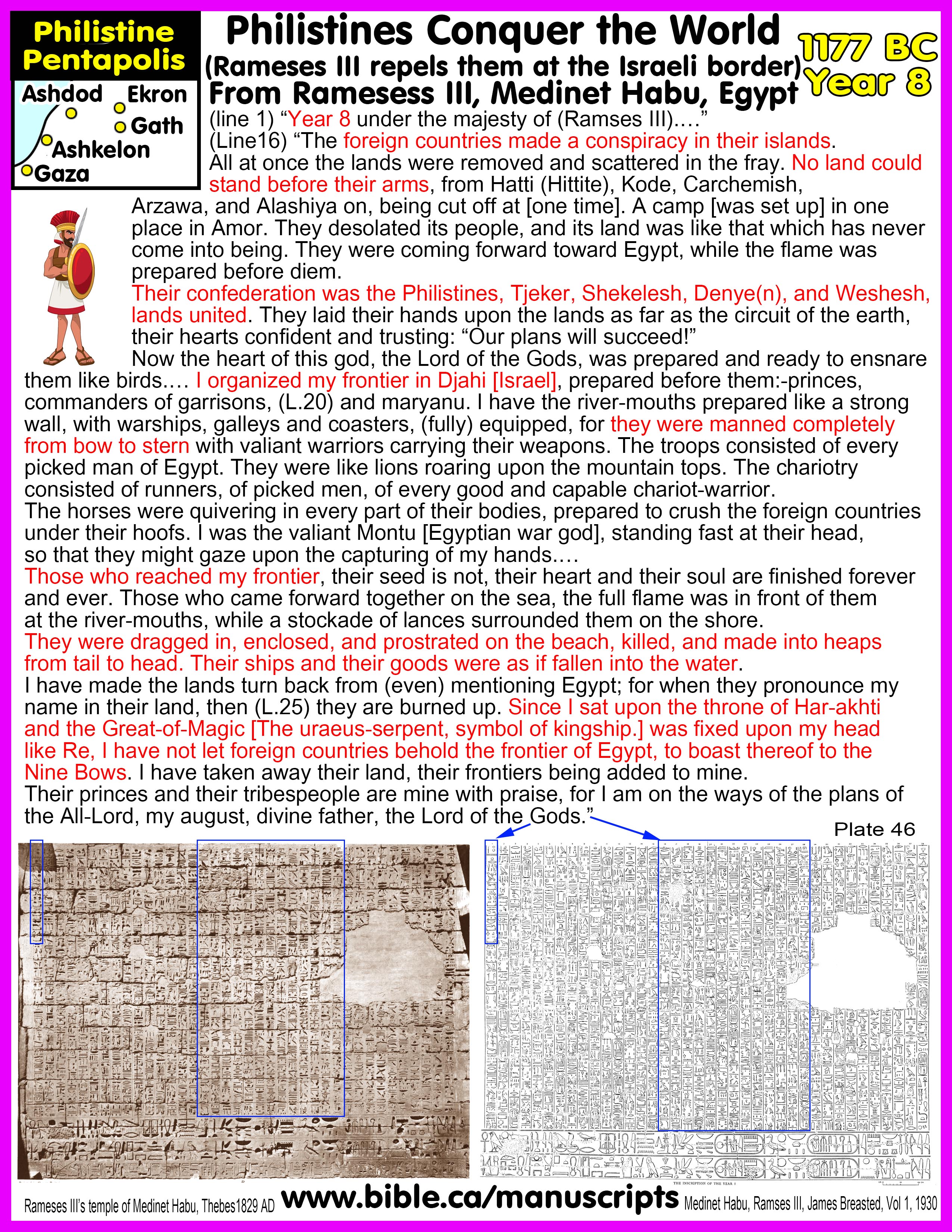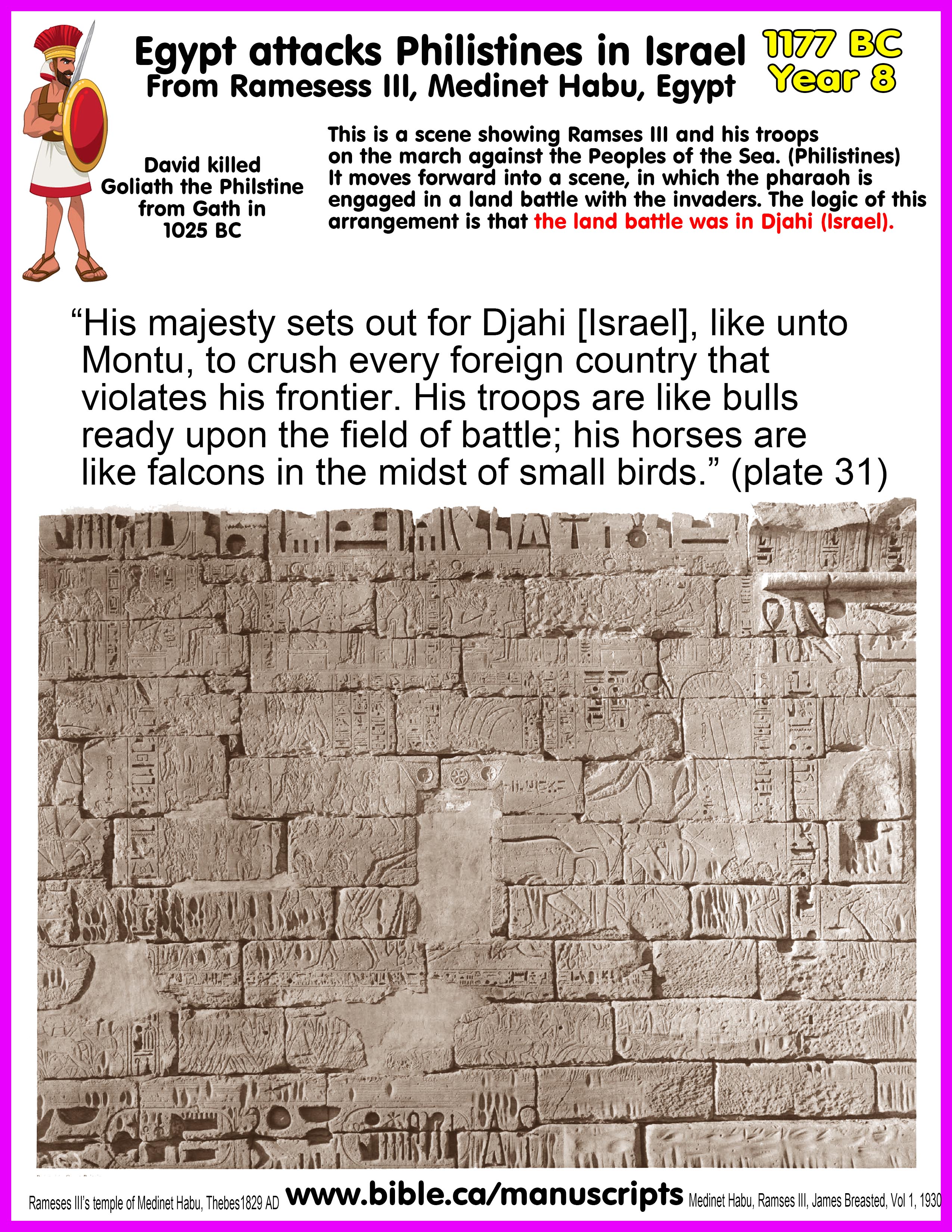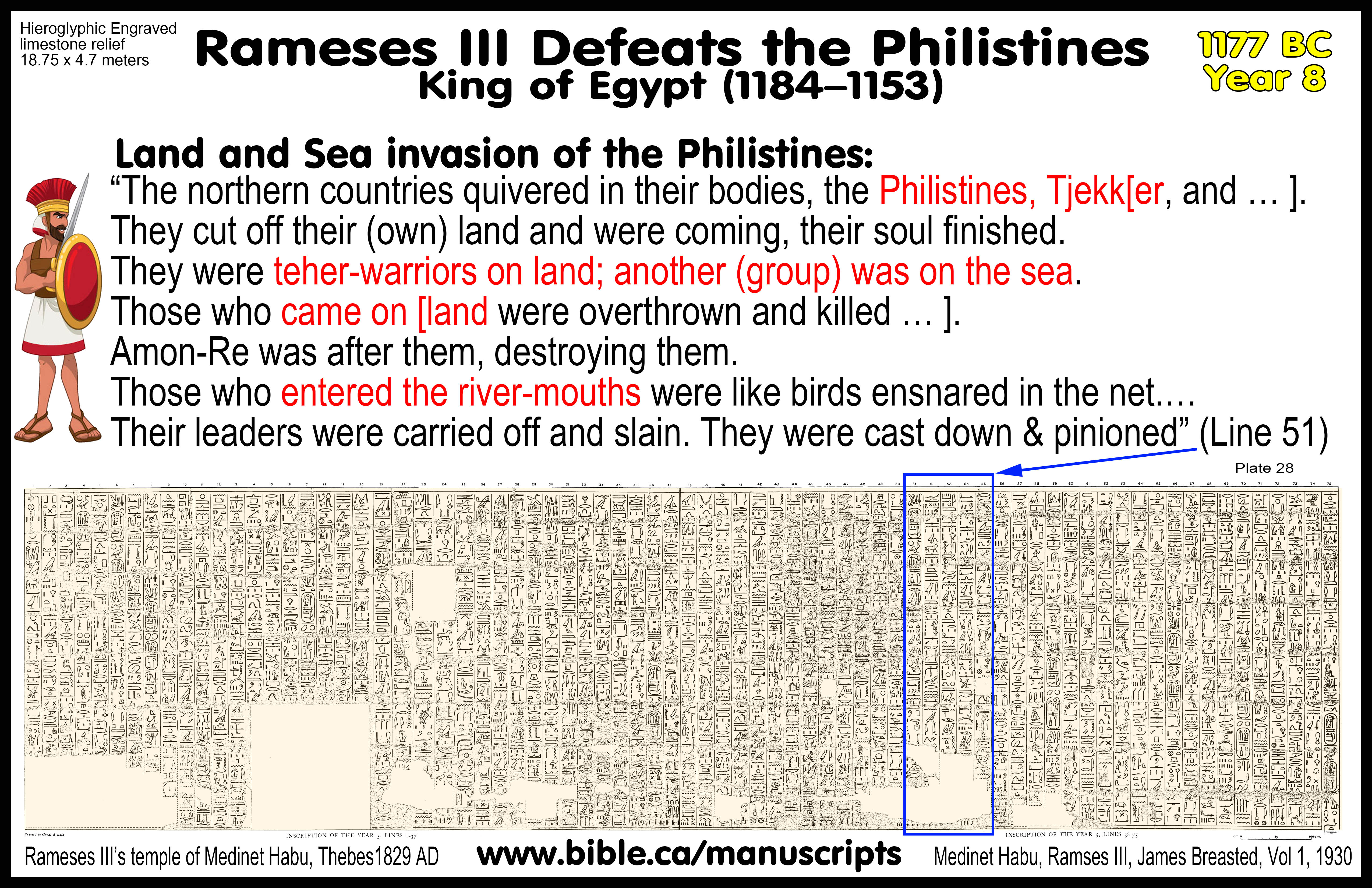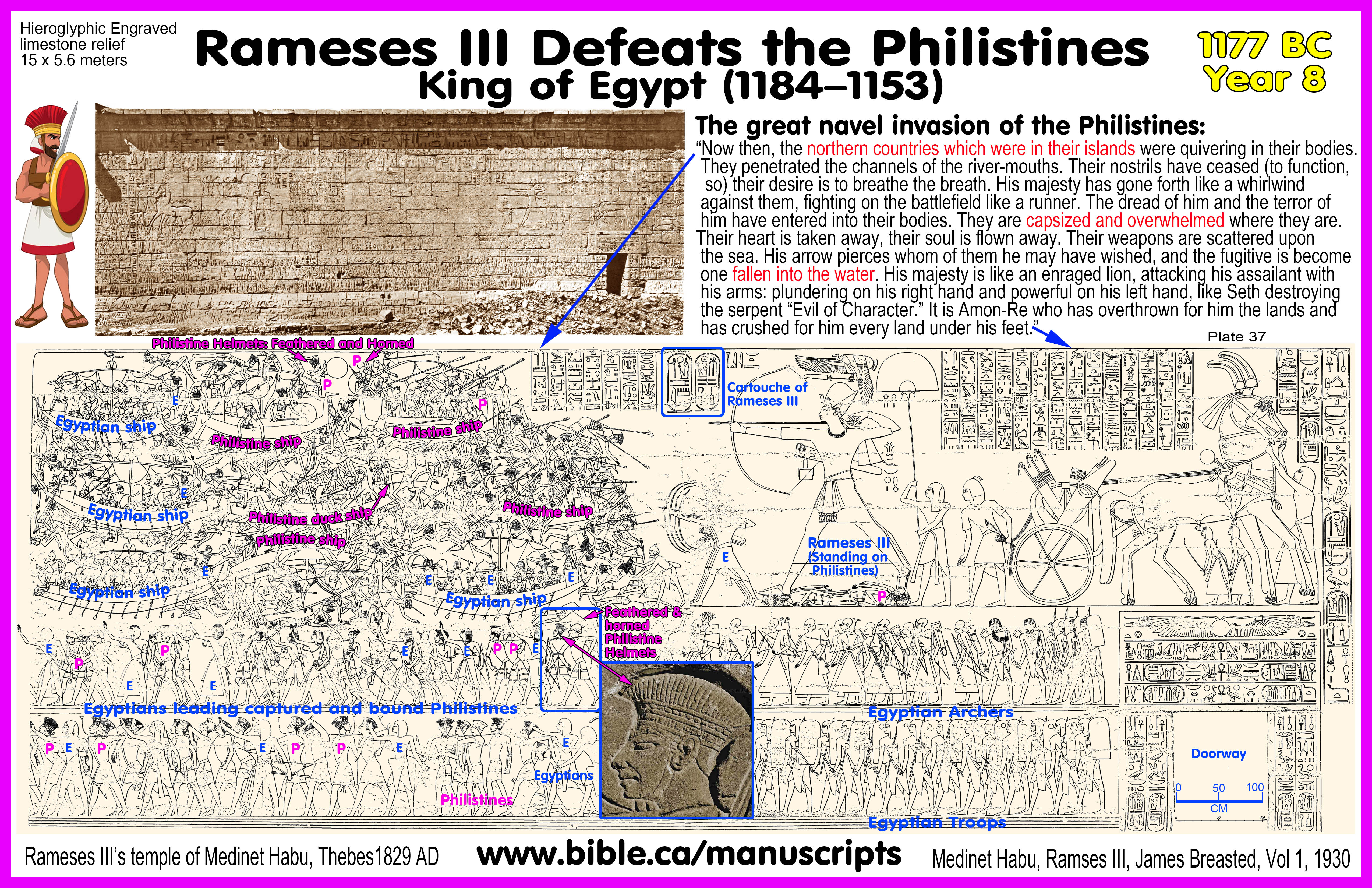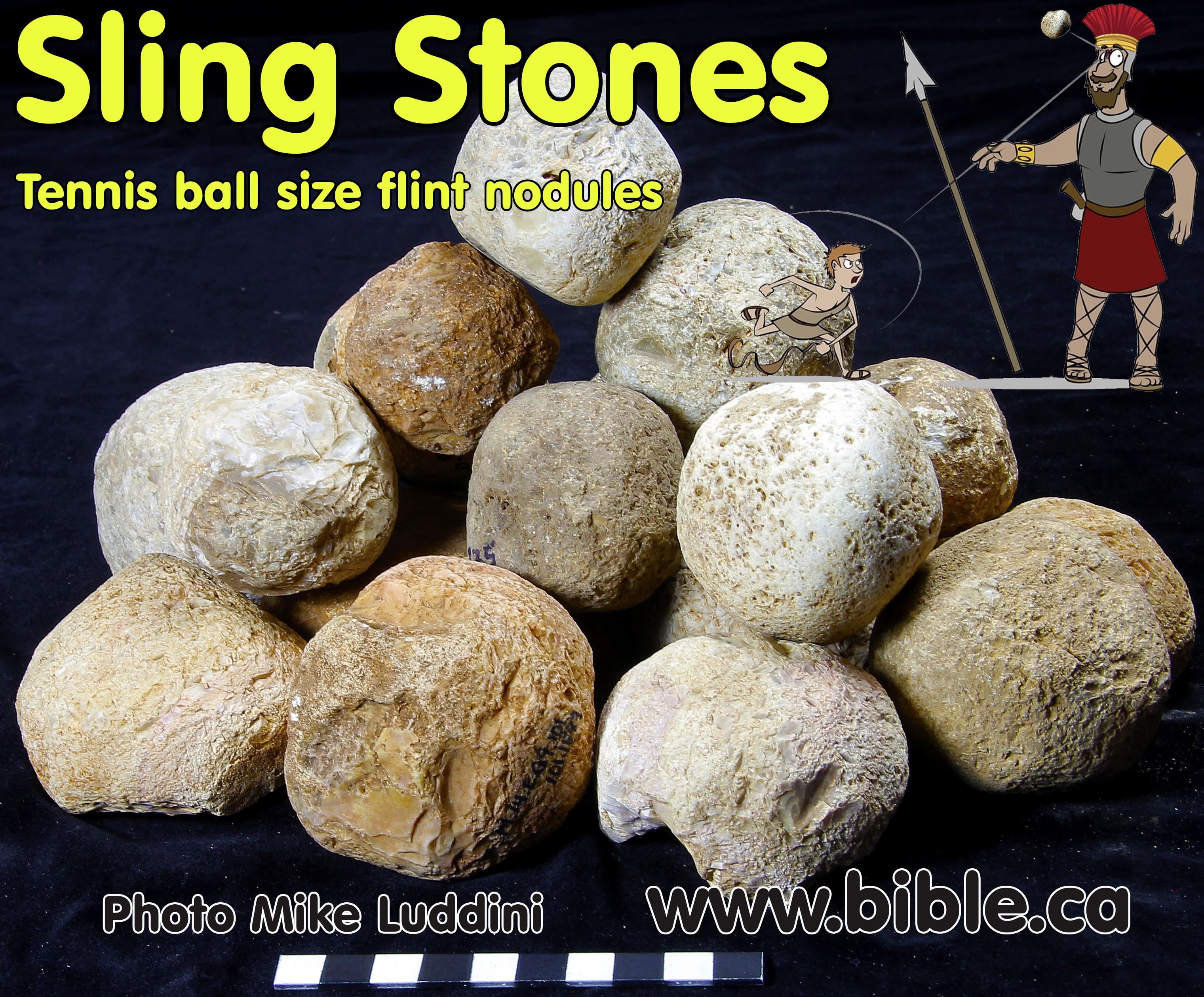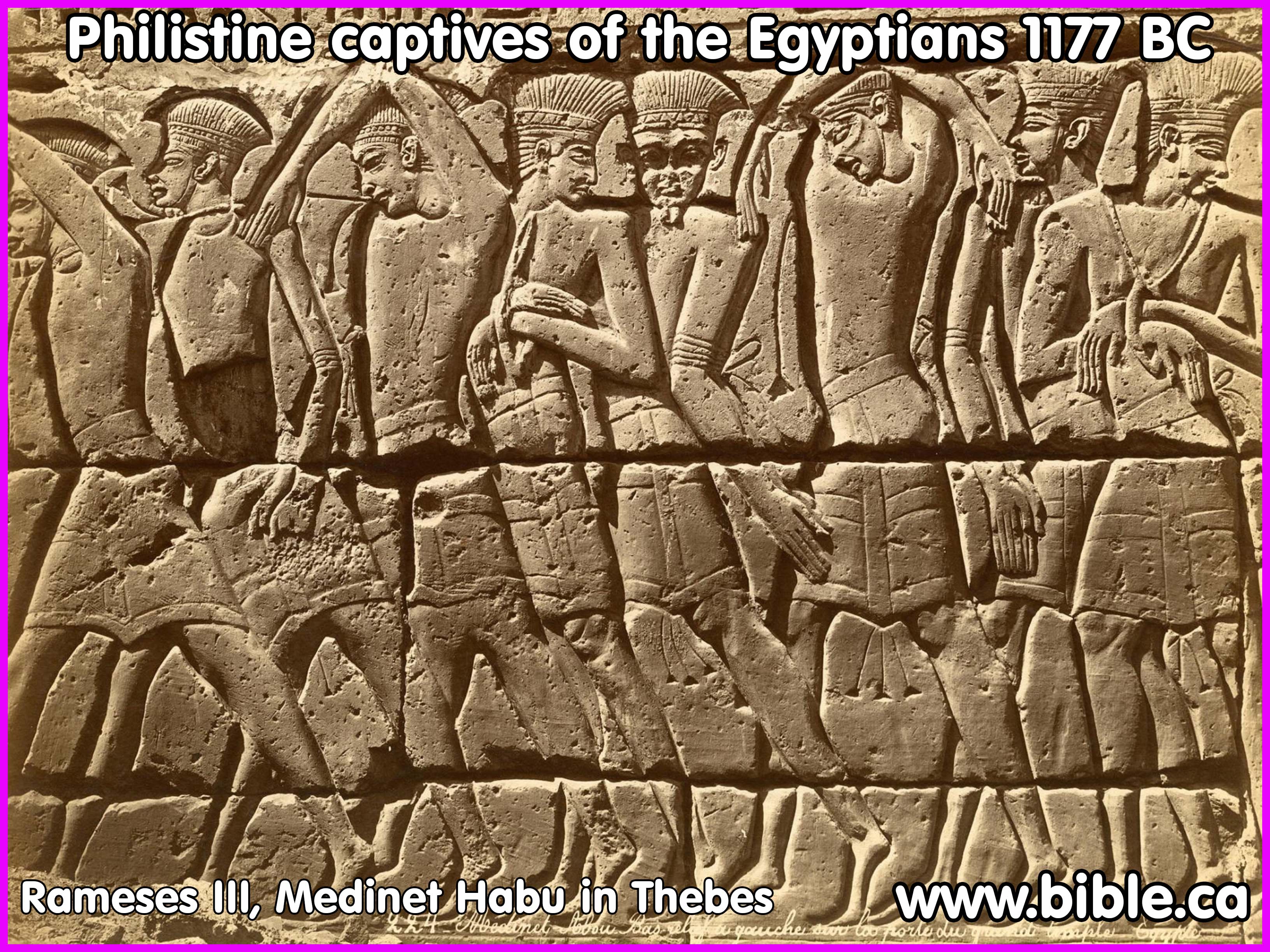Origin of the Philistines (Caphtorim): Crete (Caphtor)
Rameses III: 1184-1153 BC
Gen 10:14 Island of Crete in Aegean Sea area

|
David and Goliath (the Philistine) wearing the distinctive “feathered” war helmet. |

Quick links within this document:
II. Philistines at the time of Abraham: Gerar in 2075 BC
Philistine feathered helmet on the Phaistos disk from Crete: 1700 BC
III. Philistines Pentapolis at the time of Moses and Joshua: 1446-1356 BC
IV. Philistines at the time of Deborah and Rameses III: 1184-1153 BC
V. Philistines at the time of David: 1025-997 BC
Battle map of David and Goliath in the valley of Elah
Sling Stones used by David to kill Goliath the Philistine
VI. Philistine and Libyan Prisoners of War:
VII. Philistine war gear: Feathered and horned helmets, spears and shields: 1177 BC
VIII. Philistines trigger collapse of Bronze Age and mark beginning of Iron age: 1177 BC


1. Today, if someone calls you a PHILISTINE, that is NOT GOOD, but in ancient times, the Philistine “good guys” (heroes) of Homer’s stories on the fall of Troy in the Iliad and Odyssey were the “bad guys” (villains) in the bible.
a. The Philistines were the naval power in these stories.
b. The Iliad even identifies the Philistine trademark feathered/horsehair-plumed helmets: “On the bright ridges of the helmets, horsehair plumes touched when warriors moved their heads. That's how close they were to one another.” (Iliad 16:213-17)
2. The Minoans are the Philistines:
a. Modern scholars are sloppy in first not recognizing that Homer’s Iliad and Odyssey are about the Philistines and second, using an obscure, meaningless and confusing name for the Philistines: “The Minoans”.
b. “The scholarly label for the ancient inhabitants of Crete is “Minoans.” This artificial appellation was coined by Arthur Evans, excavator of Knossos, a major site on Crete, based on Minos, an ancient ruler of Crete known from Greek mythology. We do not know what the ancient inhabitants of Crete called themselves. Archaeological evidence indicates that the Minoans were engaged in maritime trade throughout the Levant in the Middle Bronze period (ca. 2000–1500 BC). Some of this evidence suggests that they established trading colonies in Syria, Canaan and Egypt. A small, but growing, number of finds in Palestine provide tangible evidence for contacts between Canaan and Crete long before the 12th–11th century Philistines.” (The Genesis Philistines, Bryant Wood, May 31, 2006)
3. Three Pentapolis empires in Canaan in 1406 BC at the time of the conquest of Joshua:
a. Philistine Pentapolis in coastal plain: Gaza, Ashdod, the Ashkelon, Gath, Ekron: Ex 13:17-18; Deut 2:23; Josh 11:22; 13:2-3; Judges 1:18-19; 3:1-3
i. It is possible that these five cities were abandoned by the Philistines sometime between 1356 BC (death of Joshua at 120 years) and the new wave of their arrival in 1177 BC as documented by Rameses III.
ii. "Now Joshua was old and advanced in years when the LORD said to him, “You are old and advanced in years, and very much of the land remains to be possessed. “This is the land that remains: all the regions of the Philistines and all those of the Geshurites; from the Shihor which is east of Egypt, even as far as the border of Ekron to the north (it is counted as Canaanite); the five lords of the Philistines: the Gazite, the Ashdodite, the Ashkelonite, the Gittite, the Ekronite" (Joshua 13:1-3)
iii. Moses was aware of the Philistine Pentapolis: “Now when Pharaoh had let the people go, God did not lead them by the way of the land of the Philistines, even though it was near; for God said, “The people might change their minds when they see war, and return to Egypt.” Hence God led the people around by the way of the wilderness to the Red Sea; and the sons of Israel went up in martial array from the land of Egypt.” (Exodus 13:17–18)
b. The Amorite Pentapolis in hill country: Jerusalem, Hebron, Jarmuth, Lachish, Eglon: Josh 10:5
c. Canaan Pentapolis in the north: Hazor, Madon, Shimron, Achshaph, Dor: Joshua 11:1-3,10; Judges 4:2
i. Hazor was the top king of the land over the other city kings in 1406 BC.
ii. Hazor was called the “King of Canaan” at the time of Deborah in 1200 BC.
4. Philistines conquer the world and thereby trigger the beginning of the Iron Age in 1177 BC:
a. Rameses III: 1184-1153 BC: The records of Rameses III document a great world uprising of the Philistines and describes them as unstoppable in his 8th regnal year (1177 BC)
b. The massive conquest of the Philistine empire in 1177 BC is the demarcation between the Bronze and Iron ages.
c. The Archeological Bronze Age changed to the Iron age in Canaan because of the Philistines conquered the Asia and the Levant in 1177 BC.
5. Philistine monochrome and bichrome pottery:
a. Monochrome Philistine pottery is the initial form around 1200 BC followed the following century by the introduction of bichrome forms in 1100 BC.
b. “Purely as an outsider considering the external implications, I am forced to conclude that the new series of radiocarbon dates from Cyprus and the independently derived date for the fall of Ugarit combine with separate ceramic links between Ashdod, Cyprus, and Ugarit and Tel Miqne, Cyprus, and Ugarit, respectively, to suggest that the first production of what is now often called Philistine monochrome cannot be dated much later than the beginning of the 12th century. This conclusion is arrived at quite regardless of any consideration of what, in terms of any text-based historical narrative or otherwise, this pottery may represent or of its relationship (or lack thereof) to the events attributed to Ramesses III’s Year 8 and recorded at Medinet Habu. What it means is that, as far as the debate over its chronology is concerned, Prof. Mazar appears to be right: despite the inherent uncertainty of any chronology that ultimately depends on pottery and the flexibility that has to be built into it as a result, the higher chronology to which he adheres makes much more sense in the context of our current understanding of the archaeology of the wider eastern Mediterranean than the significantly lower chronology advocated by others.” The Chronology of the Philistine Monochrome Pottery: An Outsider’s View, Susan Sherratt, Ashmolean Museum, p370, 2006 AD)
c. “The "Philistine Pottery" with its various stages (Philistine 1, 2, 3, Late Philistine Decorated Ware, etc.) begins to appear with the first appearance of the Philistine culture in Canaan (ca. late 13th to early 12th cent. BCE). The first stage (Philistine 1/Myc IIIC) is similar to pottery known from various eastern Mediterranean areas in the very late to early/mid 12th cent BCE. Myc IIIC pottery is a development of Late Helladic pottery known in the region of Greece from the Late Bronze/Late Helladic cultures of the Aegean region. But Late Helladic pottery is NOT Philistine pottery. Rather, some aspects continue in Philistine pottery - much does not.” (Aren Maeir, Director of exacavations at Gath, Email, Dec. 2018)
d.
Philistine bichrome and monochrome swirl and hash marked pottery from
Gath and Ashdod:
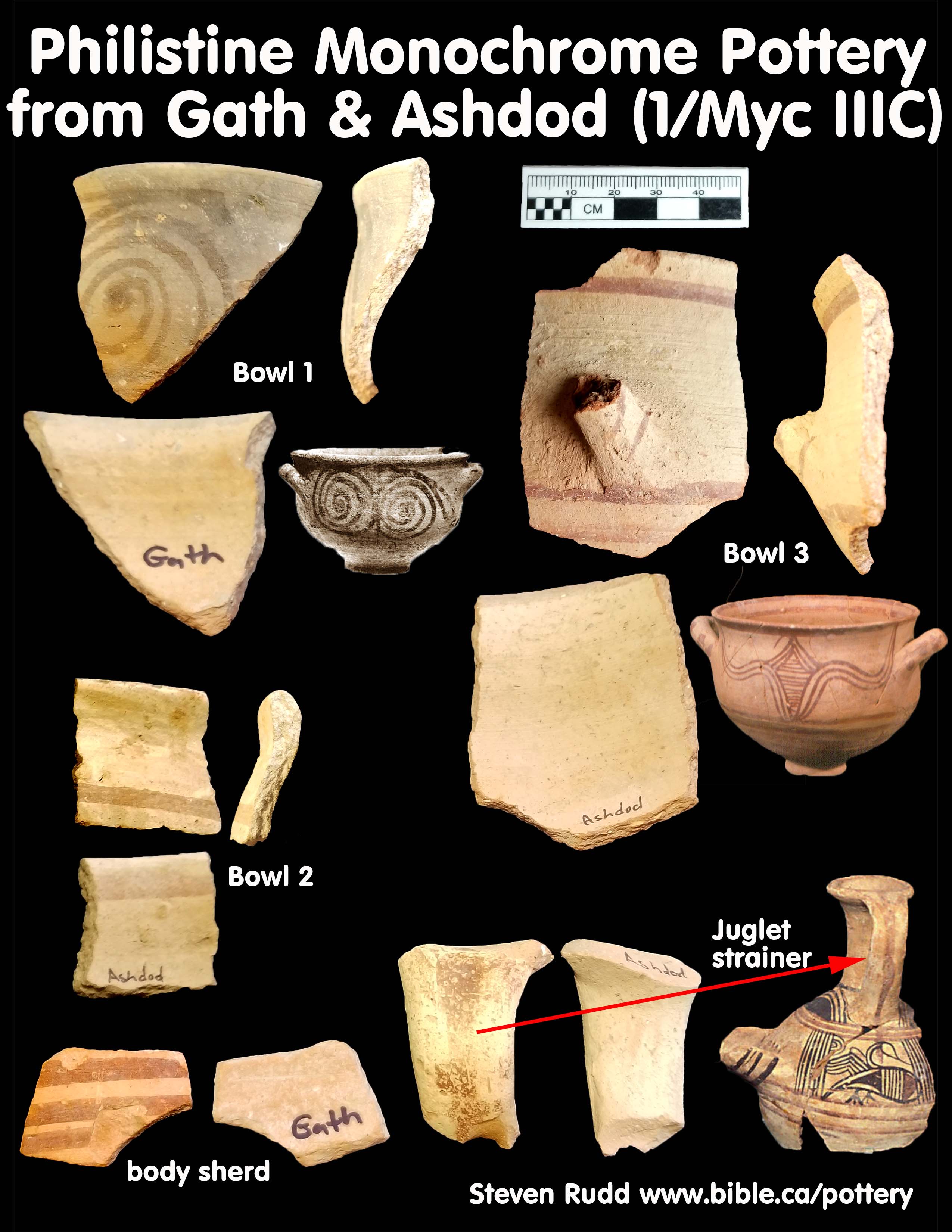

A. The Bible says that the Philistines came from “Caphtor” identified as the Island of Crete
1. The Philistines are also called “the Caphtorim”, meaning the people from Caphtor (Island of Crete). "And the Avvim, who lived in villages as far as Gaza, the Caphtorim who came from Caphtor, destroyed them and lived in their place.)" (Deuteronomy 2:23)
2. The origin of the philistines is the island of Crete and the Aegean sea area bounded by Athens, Corinth and Ephesus.
3. Crete was their home sea port base for this sea-oriented people who were likely traders and raiders (pirates).
4. “According to the Bible, the Philistines originated in “Caphtor” (Jer 47:4; Am 9:7), identified as the island of Crete (Hess 1992).” (The Genesis Philistines, Bryant Wood, May 31, 2006)
5. “Are you not as the sons of Ethiopia to Me, O sons of Israel?” declares the LORD. “Have I not brought up Israel from the land of Egypt, And the Philistines from Caphtor and the Arameans from Kir?” (Amos 9:7)
6. “On account of the day that is coming to destroy all the Philistines, To cut off from Tyre and Sidon Every ally that is left; For the LORD is going to destroy the Philistines, The remnant of the coastland of Caphtor.” (Jeremiah 47:4)
7. “Mizraim became the father of Ludim and Anamim and Lehabim and Naphtuhim and Pathrusim and Casluhim (from which came the Philistines) and Caphtorim.” (Genesis 10:13–14)
8. “therefore thus says the Lord God, “Behold, I will stretch out My hand against the Philistines, even cut off the Cherethites and destroy the remnant of the seacoast.” (Ezekiel 25:16)
B. Archeologically, the Philistines originated from Caphtor: Aegean region, western Anatolia and the Island of Crete
1. "The names Achish and Goliath are not Semitic, and parallels to these names may be found on Crete and in western Anatolia (Achtemeier 1985, 790; Buttrick 1962, 3:792; Albright 1975, 513). The biblical Achish may have had the same name as the Dardanian Anchises, the father of Aeneas from the Troad (Buttrick 1962, 3:792; T. Dothan 1982a, 22-23; Wainwright 1959, 77). The Dardanians were also on the list by Ramesses II of Hittite allies." (Philistines: Giving Goliath His Due, Neal Bierling, Ch 3)
2. "Egyptian records of the Late Bronze Age speak clearly of four localities on Crete or "Keftiu" (Kftyw), which could also be translated "Caphtor" in the Egyptian language (T. Dothan 1982a, 13, 21, and footnotes; Stiebing 1989, 175). There is almost universal agreement that the Egyptian "Kftyw" refers to Crete (Macqueen 1986, 162 n. 30). We have noted that the Bible says the Philistines came from Caphtor, which, when examined with other biblical passages, appears to be Crete. It would be reasonable to conclude that extrabiblical sources, too, seem to equate Caphtor with Crete. No doubt, as the Bible states, some of the Philistines had their origins in Caphtor/Crete. However, remember that in our examination of the Egyptian records for the Sea People invaders, during the reigns of Merneptah (ca. 1215 B.C.) and Ramesses III (ca. 1185 B.C.), we noted an Aegean -- and especially a western Anatolian -- origin for the invaders. In order to determine the heritage of the people the Bible refers to as the Philistines, I believe that we must expand the scope of our search beyond Crete to encompass the entire Aegean. With a further examination of biblical and extrabiblical material, I believe that we are even able to place part of this "Philistine" confederation on the Troad at the time of the Trojan War in the thirteenth century B.C." (Philistines: Giving Goliath His Due, Neal Bierling, Ch 3)
C. Twelve coalition sects and/or names of "Aegean Sea peoples":
1. Gittites: Bible (10 times) term for Philistines of any sect living in the city of Gath.
a. “This is the land that remains: all the regions of the Philistines and all those of the Geshurites; from the Shihor which is east of Egypt, even as far as the border of Ekron to the north (it is counted as Canaanite); the five lords of the Philistines: the Gazite, the Ashdodite, the Ashkelonite, the Gittite, the Ekronite; and the Avvite" (Joshua 13:2–3)
b. "There was war with the Philistines again at Gob, and Elhanan the son of Jaare-oregim the Bethlehemite killed Goliath the Gittite, the shaft of whose spear was like a weaver’s beam." (2 Samuel 21:19)
c. "And there was war with the Philistines again, and Elhanan the son of Jair killed Lahmi the brother of Goliath the Gittite, the shaft of whose spear was like a weaver’s beam." (1 Chronicles 20:5)
d. "And David was unwilling to move the ark of the Lord into the city of David with him; but David took it aside to the house of Obed-edom the Gittite." (2 Samuel 6:10)
2. Philistines/Peleset (Peleset named in Egyptian Medinet Habu record)
a. Pelethites may be derived from "Philistines" and "Peleset" from the Egyptian records, but this is not certain.
b. Pelethites joined David's army in 2 Samuel 15:18
3. Cherethites
a. From Island of Crete
b. People known as Cretans
c. The first mention of the Cherethites, is when the Amelekites raided them in the Negev and David at Ziglag: “We made a raid on the Negev of the Cherethites, and on that which belongs to Judah, and on the Negev of Caleb, and we burned Ziklag with fire.” (1 Samuel 30:14)
d. "therefore thus says the Lord God, “Behold, I will stretch out My hand against the Philistines, even cut off the Cherethites and destroy the remnant of the seacoast." (Ezekiel 25:16)
e. "Woe to the inhabitants of the seacoast, The nation of the Cherethites! The word of the Lord is against you, O Canaan, land of the Philistines; And I will destroy you So that there will be no inhabitant." (Zephaniah 2:5)
f. Many of the Cherethites had defected to David: 2 Samuel 8:18; 1 Kings 1:38
g. "Let us look further at the Cherethites, who composed part of David's bodyguard. First Samuel 30:14 speaks of the "Negeb of the Cherethites/Cretans." It is easy to see from the Hebrew why scholars equate Cherethite with Cretan. Cherethite is kereti. Hebrew script is consonantal, and notice that kereti has the same consonants as in the name Crete (McCarter 1980, 435; Albright 1975, 512; Stiebing 1989, 175-76). One biblical reference to the Cherethites though, 2 Samuel 20:23, reads kari rather than kereti; therefore, this reference could be translated as Carians rather than Cherethites. However, it may be concluded that at least some of the Philistines/Sea Peoples came from Crete." (Philistines: Giving Goliath His Due, Neal Bierling, Ch 3)
h. "As can be seen from the list of Ramesses III, the Egyptians considered the Philistines to be one of these invading Sea Peoples. It appears then that the Philistines can be associated with the Trojans of western Anatolia and with the Achaeans. The best areas to search for the specific point of origin of the Philistines seem to be western Anatolia, Crete, and the Greek peninsula in the locale of Athens and Mycenae." (Philistines: Giving Goliath His Due, Neal Bierling, Ch 3)
4. Caphtorites (Keftiu, Kftyw): residents of Crete also called Caphtor.
a. “Mizraim became the father of Ludim and Anamim and Lehabim and Naphtuhim and Pathrusim and Casluhim (from which came the Philistines) and Caphtorim.” (Genesis 10:13-14)
b. “Mizraim became the father of the people of Lud, Anam, Lehab, Naphtuh, Pathrus, Casluh, from which the Philistines came, and Caphtor.” (1 Chronicles 1:11–12)
c. “Egyptian records of the Late Bronze Age speak clearly of four localities on Crete or "Keftiu" (Kftyw), which could also be translated "Caphtor" in the Egyptian language. There is almost universal agreement that the Egyptian "Kftyw" refers to Crete” (Philistines: Giving Goliath His Due, Neal Bierling, Ch 3)
d. "Caphtor is referred to as Kaptara in Accadian, kptr in Ugaritic, and Keftiu in Egyptian. These references are to be dated from as early as 2200 BC down to about 1200 BC. The Egyptian sources are especially helpful in identifying Caphtor as Crete. On the other hand, there is a Jewish tradition that the Caphtorim were from Cappadocia; the Septuagint reads “Cappadocia” instead of “Caphtor.” This has led some to suggest that Caphtor is to be identified with a coastal region of Asia Minor or with the island of Carpathos. Perhaps by the 13th century BC, “Caphtor” was used in a broad sense for the Aegean area from which the Philistines came." (Tyndale Bible Dictionary, Caphtor)
e. "There is clear evidence connecting the culture of Crete with that of the Philistines. Indeed in the Bible the Philistines are sometimes mentioned in conjunction with the Cheretim. Caphtor is also mentioned in the documents of Mari and Ugarit and many scholars tend for these reasons to identify Caphtor with Crete. Others prefer to identify it with the Keptiu of the Egyptian sources, a people who dwelt in Cilicia (Asia Minor)." (Archaeological encyclopedia of the Holy Land, Caphtor)
f. "In Jeremiah 47, the prophecy promises the destruction of Tyre, Sidon, and the Philistines from Caphtor. This passage also identifies Caphtor as an island or coastland. The possibility of the relation of the Caphtorim to the Cherethites is strengthened by the latter’s association with the Philistines. A problem associated with Caphtor is its identity. Its traditional identification with Crete (Vercoutter 1956) has been challenged with the proposal of Cyprus (Strange 1980; Merrillees 1982). The issue has been addressed in three areas: archaeology, philology, and geography. As to the archaeology, the absence of Cretan ceramic wares after the mid-15th century B.C. in Egypt and Ugarit, despite the presence of textual citations for Caphtor/Keftiu until the mid-14th century in Egypt and the mid-13th century at Ugarit, has been used to argue against Crete as an identification (Merrillees 1982: 247–48). However, a similar argument could be made for the Cypriote ware in Egypt (exclusive of Amarna) at the same time (Knapp 1983: 285–86; 1985). Further, the textual and pictorial evidence in the chapel of Rekhmire is closely tied together (Vercoutter 1956: 185–88) so that attempts to separate the Keftiu from “the isles in the midst of the sea” and from the Minoan dress worn by the figures (Strange 1980: 44–70) seem strained (Görg 1982; Kitchen 1983). As to philology, the identifiable “offspring” of Egypt in Genesis 10 appears to reflect place names or people who lived in or near Egypt. The order of the names seems to be according to the number of consonants in the root, beginning with two (LUD) and proceeding to four (NAPHTUHIM and all the names of v 14). Thus the order of the names is probably not intended to follow a geographical sequence (Wenham Genesis WBC, 224). Caphtor is also mentioned in Egyptian (kftiw, kftyw), Akkadian (kap-ta-ra), Ugaritic (kptr), and Greek (kabdēros) texts (Vercoutter 1956; Strange 1980: 16–112). The 18th dynasty list of names from Egypt, with the title “to make names of Keftiu” has been used to argue a non-Greek, ancient Near Eastern environment more like Cyprus than Crete (Strange 1980: 94–96, 166). However, there can be no certainty as to what the list was intended to reflect (Astour 1982: 395) nor as to the accuracy of the analysis of the names (Vercoutter 1956: 46–47; Kitchen 1983)." (ABD, Caphtor)
5. Wasasa/Weshesh: Wasasa named in Egyptian Medinet Habu record
a. From south western Anatolia
b. People known as Carians and Carites
c. Carites mentioned in 2 Kings 11:4,19, (Carites may be a variation of spelling for Cherethites)
6. Tjekker/Tjikar: Tjekker named in Egyptian Medinet Habu record
a. Lived on Island of Cyprus and in Dor, Israel
7. Danuna/Danaoi/Denyen: Danaoi named in Egyptian Medinet Habu record
a. Same as the Homeric Danaans in the Iliad
8. Sherden named in Egyptian Karnak record
9. Tursha/Teresh/Trojans named in Egyptian Karnak record
10. Sheklesh named in Egyptian Karnak record and in Egyptian Medinet Habu record
11. Rw-ku/Lukka is named in Egyptian Karnak record
a. From land of Lukka, which is known as Lycia
b. People called Lycians
12. Ekwesh/Eqwesh is named in Egyptian Karnak record
a. Residents of Achaea in Greece
b. People called Achaeans

II. Philistines at the time of Abraham – Joseph/Ephraim
A. Philistine territory at the time of Abraham included Gerar:
1. In 2075 BC, the Philistine capital in Canaan was at Gerar at the time of Abraham and Isaac:
a. Although the global capital of the Philistines was always Crete but in Canaan, their local “city state” was headed at Gerar near Gaza.
b. The Philistines were already well established in the land in 2075 BC since Abraham and Sarah encountered Abimelech king of the Philistines in the city of Gerar.
c. “So they made a covenant at Beersheba; and Abimelech and Phicol, the commander of his army, arose and returned to the land of the Philistines. Abraham planted a tamarisk tree at Beersheba, and there he called on the name of the Lord, the Everlasting God. And Abraham sojourned in the land of the Philistines for many days.” (Genesis 21:32–34)
d. “Now there was a famine in the land, besides the previous famine that had occurred in the days of Abraham. So Isaac went to Gerar, to Abimelech king of the Philistines.” (Genesis 26:1)
2. Archeological excavations at Gerar:
a. “Of particular interest is a Minoan graffito found in the sacred precinct dating to ca. 1600 BC. Analyses of the sherd determined that it originated in Crete, most likely the south coast (Day et al. 1999; Oren et al. 1996). There are four Minoan signs on the graffito, inscribed prior to firing, which represent a bull’s head, cloth, branch and figs (Oren et al. 1996: 99–109). In addition to the graffito, an unusual chalice of Canaanite shape and fabric was found in a room on the east side of the sacred area. What makes the chalice unusual is its high arching handles, a well-known feature of Minoan chalices, but not of Canaanite (Oren et al. 1996: 95, 96; Oren 1993: 581).” (The Genesis Philistines, Bryant Wood, May 31, 2006)
3. In 1 Chronicles 7:20-22, Ephraim’s two sons are killed by the men of Gath.
a. Although the Philistines are not named, we know the Philistine Pentapolis that included Gath existed at the time of Joshua.
b. The reference to Gath may be to Gittaim: 2 Samuel 4:3
B. Philistine feathered helmet on the Phaistos disk from Crete: 1700 BC
1. The importance of the Phaistos disk cannot be understated.
c. Bible-trashers say that the references to Philistines in Genesis at the time of Abraham are mythical and the Bible is wrong.
a. The feathered Philistine helmet is clearly seen many times on the disk which dates to 1700 BC, which is 150 years before the exodus.
b. This provided archeological evidence that the Philistines with their distinctive war helmets were in existence only 300 years after Abraham and 150 years before Moses.
d. In 1908 AD, the disk was discovered in Phaistos, Crete while the site was being professionally excavated.
e. Several other artifacts have been excavated with similar designs and symbols on them.
C. About the Phaistos Disk:
1. “The Phaistos Disk is a round clay tablet 61/2 inches in diameter discovered during excavations at the palace of Phaistos in S Crete in 1908 and dated stratigraphically to the 17th century b.c.e. The disk is inscribed on both sides with a pictographic script that is not apparently related to other Cretan scripts. The number of individual pictographs used on the disk is 45, a fact that suggests a syllabic script. The most noteworthy aspect of the writing is that the signs were not incised or drawn into the clay, but rather made by impressing stamps, in history’s first example of movable type. None of the numerous attempts at deciphering the relatively short text has gained acceptance; the language of the inscription has thus also remained unknown.” (ABD, Languages, Vol 4, p165)
2. “This can be seen on the famous Phaistos Disc (ca. 1600 B.C.) where there is a picture of a man wearing the famous “feathered” headdress of the Philistines. This same headdress is worn by Philistine soldiers in Egyptian artwork depicting the Egyptian battles fought against the Sea Peoples in ca. 1200 B.C. But the best proof of some sort of a connection between the ancient Minoans and the Philistines is to be seen in two temples: one found at Anemospilia on the Island of Crete and the other found at the site of the ancient Philistine city of Ekron in Canaan.” (Did Abraham Learn Human Sacrifice From The Philistines? A Comparative Study of Two Temples, One Minoan and One Philistine, Clyde E. Billington, The Near East Archaeological Society Bulletin: New Series, Nos. 39–40, p 26, 1995 AD)
3. “Most importantly, pictographic signs that were documented for the first time on the Phaistos disk were later found on other inscribed artefacts as well – on the Arkalochori axe, on the Malia altar stone and on the sealing HM 992 from Phaistos.” (Notes on the Authenticity of the Phaistos Disk, Pavol Hnila, Anodos. Studies of the Ancient World p 59-66, 2009 AD)
D. Some wrongly suggest that the Phaistos disk is a forgery:
1. The “typeset” stamped style of the disk is unique in the ancient world. To professional archeologists, the stamped characters look like a high-school hoax with the expectation that no one would take it seriously.
2. “The terracotta Phaistos disk is strikingly similar to a lead disk inscribed in Etruscan found in Magliano, Italy. Both objects are roughly circular and both are covered by text placed along lines forming a spiral. The Magliano disk was known already by the end of 19th century, and Eisenberg sees in it the inspiration for the Phaistos disk. Pernier was well aware of the parallels and he included photographs of the Magliano disk in his publication of the Phaistos disk. This can be viewed either as a sophisticated attempt to imply connections between Crete and Etruria at a time when still little was known about Minoan civilization, or simply as another proof of Pernier’s scientific sincerity. The only other Minoan artefact with an inscription written along a spiraliform line is a gold ring from Mavro Spilaio. Though the ring was found during Evans’s excavation in 1926, Eisenberg questions its authenticity. The diameter of the ring is only 13 mm, which makes it difficult to actually wear it. Perhaps the ring was worn by a child, The ring of Mavro Spilio with an inscription in Linear A or by an adult on the little finger, or it was not made to be worn in the first place. Producing a forgery in gold is more difficult and costly than producing one in clay. If there is no specific scientific motive, it makes little sense to smuggle a faked golden ring into an excavation, as the forger would probably only receive a cash reward far lower than the price obtainable on the antiquities’ market. The ring is therefore likely to be a genuine artefact and its existence proves the occasional use of a spiral layout for text arrangements on Minoan Crete.” (Notes on the Authenticity of the Phaistos Disk, Pavol Hnila, Anodos. Studies of the Ancient World p 59-66, 2009 AD)
3. “The much-invoked thermoluminiscence analysis of the disk might bring about some light in the darkness. Yet, it is a destructive method and there is no real guarantee that the results will be free of any ambivalence. The research must continue, but in conclusion, let us set one thing straight: until someone proves unequivocally that a forgery took place, Luigi Pernier, his team members and Émile Gilliéron senior should not be accused.”(Notes on the Authenticity of the Phaistos Disk, Pavol Hnila, Anodos. Studies of the Ancient World p 59-66, 2009 AD)
E. Other archeological finds that corroborate the Phaistos disk from Crete:
1. Seal HM 992:
a. Seal HM 992 Phaistos Crete was excavated by Doro Levi in 1955 AD
b. It features the unique “comb” symbol: See #21 on Phaistos Disk
2. Blue Limestone Altar Stone:
a. Blue Limestone Altar Stone was a surface find by farmer in 1937 AD at Malia Crete
b. It features many similar characters found on the Phaistos disk.
3. Arkalochori Cave Axe:
a. Arkalochori Cave Axe was excavated in 1934 on Crete by Spyridon Marinatos
b. It features many similar characters found on the Phaistos disk: See #2, 19, 35 on Phaistos Disk
4. Lead Magliano Disk:
a. The “Lead Magliano Disk” is a Double sided, spiral-inscribed metal disk discovered in Italy in 1882 AD
b. It is from the Etruscan culture dating to 600-500 BC.
c. It features a spiral text on both sides like the Phaistos disk but the characters are not similar at all.
5. Mavro Spilio Gold Ring:
a. The “Mavro Spilio Gold Ring” features a spiral text and was discovered in the Necropolis of Mavro Spileo (Knossos) Crete, and dates to 1500 BC
b. The spiral design is similar to the Phaistos disk.

III. Philistines Pentapolis at the time of Moses and Joshua: 1446-1406 BC
A. The six city state empires of the Amorites and Philistines in 1406 BC:
1. Philistine Pentapolis of city states
a. Gaza, Ashdod, Ashkelon, Gath, Ekron
b. in coastal plain
c. Archeology of the Philistine pottery has confirmed that Ashkelon was the production center for the monochrome Canaan Philistine pottery, so it was most likely also the capital of the Pentapolis. Ashkelon is also a huge ancient city that has one of two in situ clay brick arched city gates (the other is at Tel Dan).
d. Ex 13:17-18; Deut 2:23; Josh 11:22; 13:2-3; Judges 1:18-19; 3:1-3
i. "Now Joshua was old and advanced in years when the Lord said to him, “You are old and advanced in years, and very much of the land remains to be possessed. “This is the land that remains: all the regions of the Philistines and all those of the Geshurites; from the Shihor which is east of Egypt, even as far as the border of Ekron to the north (it is counted as Canaanite); the five lords of the Philistines: the Gazite, the Ashdodite, the Ashkelonite, the Gittite, the Ekronite" (Joshua 13:1-3)
ii. "Now these are the nations which the Lord left, to test Israel by them (that is, all who had not experienced any of the wars of Canaan; only in order that the generations of the sons of Israel might be taught war, those who had not experienced it formerly). These nations are: the five lords of the Philistines and all the Canaanites and the Sidonians and the Hivites who lived in Mount Lebanon, from Mount Baal-hermon as far as Lebo-hamath." (Judges 3:1-3)
2. Amorite Pentapolis of 112 city states in Judea
a. Jerusalem, Hebron, Jarmuth, Lachish, Eglon
b. In hill country (Jerusalem is capital)
c. "So the five kings of the Amorites, the king of Jerusalem, the king of Hebron, the king of Jarmuth, the king of Lachish, and the king of Eglon, gathered together and went up, they with all their armies, and camped by Gibeon and fought against it." (Joshua 10:5)
3. Amorite 15 city state Basham empire
a. King Jabin at Hazor
b. Hazor, Madon, Shimron, Achshaph, Dor
c. Joshua 11:1-3,10; Judges 4:2
i. "Then it came about, when Jabin king of Hazor heard of it, that he sent to Jobab king of Madon and to the king of Shimron and to the king of Achshaph, and to the kings who were of the north in the hill country, and in the Arabah—south of Chinneroth and in the lowland and on the heights of Dor on the west— to the Canaanite on the east and on the west, and the Amorite and the Hittite and the Perizzite and the Jebusite in the hill country, and the Hivite at the foot of Hermon in the land of Mizpeh." (Joshua 11:1–3)
ii. Hazor was the top king of the land over the other city kings in 1406 BC: "Then Joshua turned back at that time, and captured Hazor and struck its king with the sword; for Hazor formerly was the head of all these kingdoms." (Joshua 11:10)
iii. Hazor was called the “King of Canaan” at the time of Deborah in 1200 BC: "And the Lord sold them into the hand of Jabin king of Canaan, who reigned in Hazor; and the commander of his army was Sisera, who lived in Harosheth-hagoyim." (Judges 4:2)
4. Amorite 60 city states Bashan empire
a. King Og of Bashan at Ashtaroth
b. Deut 3:4; 4:47; Josh 12:4-5; 13:30-31; Neh 9:22;
5. Shechem/Shiloh city state empire
a. Being Hebrew friendly & joined Joshua is confirmed in Amarna Letters below:
b. Shechem: Amarna Letters: EA246, 254, 244, 289
c. Shiloh: Amarna letter: EA288
d. Detailed outline on the Amarna Tablets
6. Amorite city state empire at Hesbon
a. King Shihon at Heshbon
b. Deut 4:47; Josh 12:2; 13:27; Neh 9:22;
B. Chronology of the Philistine Pentapolis:
1. 1446 BC: The exodus of the Jews began at Goshen and went south not west:
a. At the time of the Exodus the Philistine Pentapolis was in full operation: Philistine Pentapolis: Ashdod, Gaza, Ashkelon, Gath, Ekron.
b. At the time of the Exodus, the Philistines probably also continued to occupy Gerar as they had from the time of Abraham.
c. “Now when Pharaoh had let the people go, God did not lead them by the way of the land of the Philistines, even though it was near; for God said, “The people might change their minds when they see war, and return to Egypt.” Hence God led the people around by the way of the wilderness to the Red Sea; and the sons of Israel went up in martial array from the land of Egypt.” (Exodus 13:17–18)
d. The “Way of Horus” was an ancient road that started at Goshen (Tel el-Dab’a, Avaris) and flanked the coastline north to Tyre, Sidon and Biblos etc.
e. The “land of the Philistines” in Ex 13:17 = Philistine Pentapolis: Ashdod, Gaza, Ashkelon, Gath, Ekron
2. 1406 BC: God told Moses at the Arnon river at the time of the conquest:
a. "And the Avvim, who lived in villages as far as Gaza, the Caphtorim who came from Caphtor, destroyed them and lived in their place." (Deuteronomy 2:23)
b. We have direct confirmation from the mouth of God that the Philistines from Crete conquered Gaza and occupied it before 1406 BC.
c. In 1406 BC, the Amorite Pentapolis of five cities controlled that area that would become the Philistine Pentapolis, but with different cities.
3. 1399 BC: Joshua gave Judah the five Philistine Pentapolis cities as their tribal allotment:
a. "Ekron, with its towns and its villages; from Ekron even to the sea, all that were by the side of Ashdod, with their villages. Ashdod, its towns and its villages; Gaza, its towns and its villages; as far as the brook of Egypt and the Great Sea, even its coastline." (Joshua 15:45–47)
b. Gath is not mentioned specifically but it is clearly inside Judah’s inheritance.
c. Gath was a Philistine stronghold at the time of the conquest where the giants continued to live after Joshua’s death.
d. Ekron appears to be part of the Danite territory too, so perhaps Judah possessed up to the borders of Ekron but not the city itself.
e. It made little difference who controlled Ekron because faithless Dan moved north and abandoned their historic inheritance.
4. 1399 BC: Joshua allotted the tribe of Dan much of the rich fertile land where the coastal Philistines and the Canaanites to the north lived.
a. "The seventh lot fell to the tribe of the sons of Dan according to their families. The territory of their inheritance was Zorah and Eshtaol and Ir-shemesh, and Shaalabbin and Aijalon and Ithlah, and Elon and Timnah and Ekron, and Eltekeh and Gibbethon and Baalath, and Jehud and Bene-berak and Gath-rimmon, and Me-jarkon and Rakkon, with the territory over against Joppa." (Joshua 19:40–46)
b. In 1340 BC: The faithless tribe of Dan was unable to live in their allotted area because it was occupied by Amorites (not Philistines): "Then the Amorites forced the sons of Dan into the hill country, for they did not allow them to come down to the valley." (Judges 1:34)
c. What is interesting is that the term “Amorites” sometimes is used in the Bible as a generic foreign nation as a synonym for many other specific nations including the Philistines. For example the king of Jerusalem is called an Amorite, yet we know they were Jebusites.
5. 1356 BC: Around time Joshua died, the Philistine Pentapolis was in full operation and controlled the coastline of Canaan:
a. "Now these are the nations which the Lord left, to test Israel by them (that is, all who had not experienced any of the wars of Canaan; only in order that the generations of the sons of Israel might be taught war, those who had not experienced it formerly). These nations are: the five lords of the Philistines and all the Canaanites and the Sidonians and the Hivites who lived in Mount Lebanon, from Mount Baal-hermon as far as Lebo-hamath." (Judges 3:1–3)
b. “the five lords of the Philistines: the Gazite, the Ashdodite, the Ashkelonite, the Gittite, the Ekronite" (Joshua 13:1-3)
c. Goliath was descended from the giants (Anakim) from Gath from the time of Joshua: "There were no Anakim left in the land of the sons of Israel; only in Gaza, in Gath, and in Ashdod some remained." (Joshua 11:22)
d. "And Judah took Gaza with its territory and Ashkelon with its territory and Ekron with its territory. Now the Lord was with Judah, and they took possession of the hill country; but they could not drive out the inhabitants of the valley because they had iron chariots." (Judges 1:18-19)

IV. Philistines at the time of Deborah and Rameses III: 1184-1153 BC
A. In 1177 BC the Philistines conquer the world triggering the collapse of Late Bronze age society:
1. Rameses III: 1184-1153 BC: 8th year is 1177 BC:
a. “Much of what we know about the Philistine appearance in Canaan is based on hieroglyphic texts and pictorial reliefs in the magnificent mortuary temple of Pharaoh Ramesses III (c. 1184–1153) at Medinet Habu in the Theban necropolis in Egypt. There we learn of a major confrontation between the Egyptians and a coalition of displaced groups referred to as the “Sea Peoples.” This confrontation took place in the eighth year of Ramesses III, that is, about 1177 B.C. Throughout this article, I follow the [low] chronology of Kenneth A. Kitchen.” (The Philistines Enter Canaan, Bryant G. Wood, BAR 17:06, Nov/Dec 1991 AD)
2. The Philistines arrived in a series of migration “waves” at the time of Abraham, Moses and Deborah (Rameses III: 1184-1153 BC)
3. Although the Philistines were already occupying their Pentapolis, in 1177 BC, there was a huge swell of Philistine power resulting in them conquering the entire Mediterranean world.
4. “Pharaoh Rameses III recorded that the Philistines were one tribe of a coalition of “Sea Peoples” who swept across Anatolia (modern Turkey) and down the Mediterranean coast intent on taking up residence in Egypt. In his eighth year (ca. 1177 BC), Rameses III turned them back at the border and the various tribes of the Sea Peoples were forced to settle elsewhere. The Philistines ended up in one of the choicest areas of Palestine, the southwest coastal region. Archaeologists have been able to track their presence there because of their distinctively Aegean material culture, especially their pottery (Wood 1991). According to the Bible, the Philistines originated in “Caphtor” (Jer 47:4; Am 9:7), identified as the island of Crete (Hess 1992).” (The Genesis Philistines, Bryant Wood, May 31, 2006)
5. The radiocarbon results, in relation to archaeological and historical data, lead us to propose a date of 1194–1190 BC for the Sea People event in the northern Levant. This radiocarbon-based archaeological date can be refined with the astronomical observation related on the cuneiform tablet KTU 1.78 (RS 12.061) found among the ruins of Ugarit. The sun eclipse depicted on the cuneiform tablet KTU 1.78 was dated to the 21 January 1192 BC [31], suggesting that the destruction of the city and the fall of the kingdom occurred after this observation. The date of 1192–1190 BC for the Sea People invasions in the northern Levant, and the end of the ancient Eastern Mediterranean world fits the radiocarbon, historical, archaeological and astronomical data. … Our research suggests that the traditional Egyptian date for the decline of the ancient Mediterranean world, based on sources from Ramses III's reign, only corresponds to the final part of a more complex and longer-term event that intensified after 1215 BC with the first written evidence of food shortage. According to the Great Harris Papyrus and to the scenes of naval and land battles depicted at Medinet Habu (Thebes, Upper Egypt), Ramses III defeated the Sea Peoples during the 8th year of his reign. The first regnal year of Ramses III is variously dated in the literature, giving historical dates of 1176 BC, 1179 BC, and a radiocarbon-based date of 1188–1177 BC for the Sea People invasions in the Nile delta. According to the 1192–1190 BC proposed date, the civilizations of the Aegean and Eastern Mediterranean were devastated long before the war the Sea Peoples waged against Ramses III's army. By a combined use of radiocarbon, archaeological and historical data, the first firm date of 1192–1190 BC is proposed for the terminal destruction and disintegration of Late Bronze Age societies in the Northern Levant. The collapse caused by the Sea Peoples marks a historical watershed and from these crisis years arose a new world. Later, the Greeks narrated and heroised this period with the myths and stories on the fall of Troy (Homer's Iliad and Odyssey). Some of the Sea Peoples, the Philistines, received a significant recognition in Biblical texts, and the name Palestine derives from these settlers. (The Sea Peoples, from Cuneiform Tablets to Carbon Dating, David Kaniewski, 2011 AD)
6. “The sixth and seventh peoples, the Casluhites and Caphtorites, must be treated together since our understanding of these peoples is related to the phrase “from whom the Philistines came” (v. 14). We do not know the location of the Casluhites, but there is wide agreement that Caphtor is the Aegean isle Crete. The association of Cretan culture with Egypt has long been established. Amos 9:7 and Jer 47:4, as well as extrabiblical sources, indicate that the Philistines were from Caphtor (Crete). In the table, however, the origins of the Philistines are attributed to the unknown Casluhites. Commonly, interpreters emend the reading of the text by taking the last clause with “Caphtorites” rather than Casluhites, thereby resolving the apparent tension between the sources. Alternatively, the addendum “Philistines,” as it stands, is recognized as a necessary explanation of Philistine origins that was based on an authentic early memory, namely, that the Philistines originally descended from the Casluhites. … Others, as we will see next, argue that there are two migrations in view, an earlier group that Abraham and Isaac encountered in Canaan and a subsequent migration among the Sea Peoples (ca. 1200 b.c.). (Yale Bible dictionary)
7. “In the latter half of the second millennium b.c. there were extensive movements in the eastern Mediterranean area. Masses of homeless peoples moved slowly across the sea and its coast-lands, displacing or merging with the older populations. These migrations ended the Minoan civilization in Crete, contributed to the historical populations of Greece and Italy, wiped out the Hittite Empire, thrust the Philistines into Canaan, and washed up on the shores of Egypt. In Ramses III’s eighth year the pharaoh met and checked their attempt to push into the rich lands of the Nile. The victory was only a check, because the Egyptian Empire in Asia ended shortly after. The following accounts of this war come from Ramses III’s temple of Medinet Habu at Thebes.” (ANET 262)
B. Philistine conquest of 1177 BC (Year 8) from Ramses III’s temple of Medinet Habu at Thebes:
1. Plate 46: Philistines conquer the world, attack Israel, Rameses III repels them at the border: 1177 BC:
a. Discussion of Plate 46: The hieroglyphic inscription is from a large wall relief that features vertical lines of text. The Philistines had controlled the 5 cities of their Pentapolis since the time of Moses, but now a new influx of Philistine warriors reinforced, rejuvenated and solidified their power in their historic territory on the coastal plain. It describes how the Philistines are unstoppable. However, Rameses III successfully repelled their attack of Egypt by setting up a frontier battle line at the Wadi El-Arish (the border between Egypt and Israel). Notice the inscription lists the coalition of nations fighting with the Philistines:
b.
Translation #1 of Plate 46: Lines 1-27
“(1) Year 8 under the majesty of (Ramses III).… (16) … The
foreign countries made a conspiracy in their islands. All at once the
lands were removed and scattered in the fray. No land could stand before their
arms, from Hatti (Hittite), Kode, Carchemish, Arzawa, and Alashiya on,
being cut off at [one time]. A camp [was set up] in one place in
Amor. They desolated its people, and its land was like that which has never
come into being. They were coming forward toward Egypt, while the flame was
prepared before diem. Their confederation was the Philistines, Tjeker,
Shekelesh, Denye(n), and Weshesh, lands united. They laid their hands upon the lands as far as the circuit of
the earth, their hearts confident and trusting: “Our plans will succeed!” Now
the heart of this god, the Lord of the Gods, was prepared and ready to ensnare
them like birds.… I [Rameses III] organized my frontier in Djahi [Israel], prepared before them:—princes,
commanders of garrisons, (20) and maryanu. I have the river-mouths
prepared like a strong wall, with warships, galleys and coasters, (fully)
equipped, for they were manned completely from bow to stern with valiant
warriors carrying their weapons. The troops consisted of every picked man of
Egypt. They were like lions roaring upon the mountain tops. The chariotry
consisted of runners, of picked men, of every good and capable
chariot-warrior. The horses were quivering in every part of their bodies,
prepared to crush the foreign countries under their hoofs. I was the valiant
Montu [Egyptian war god], standing fast at their head, so that they might gaze
upon the capturing of my hands.…* Those who reached my frontier,
their seed is not, their heart and their soul are finished forever and ever.
Those who came forward together on the sea, the full flame was in front of them
at the river-mouths, while a stockade of lances surrounded them on the
shore. They were dragged in, enclosed, and prostrated on the beach, killed, and
made into heaps from tail to head. Their ships and their goods were as if
fallen into the water. I have made the lands turn back from (even) mentioning
Egypt; for when they pronounce my name in their land, then (25) they are burned
up. Since I sat upon the throne of Har-akhti and the Great-of-Magic [The
uraeus-serpent, symbol of kingship.] was fixed upon my head like Re, I have not
let foreign countries behold the frontier of Egypt, to boast thereof to the
Nine Bows. I have taken away their land, their frontiers being added to mine.
Their princes and their tribespeople are mine with praise, for I am on the ways
of the plans of the All-Lord, my august, divine father, the Lord of the Gods.”
(Medinet Habu: Earlier Historical Records of Ramses III, James Breasted, Vol 1,
1930, Plate 46, lines 1-27)
c.
Translation #2 of Plate 46: lines 1,16, 31
"Year 8 under the majesty of (Ramses III).…The foreign countries made
a conspiracy in their islands. All at once the lands were removed and scattered
in the fray. No land could stand before their arms, from Hatti, Kode,
Carchemish, Arzawa, and Alashiya on, being cut off at [one time]. A camp [was
set up] in one place in Amor. They desolated its people, and its land was like
that which has never come into being. They were coming forward toward Egypt,
while the flame was prepared before diem. Their confederation
was the Philistines, Tjeker, Shekelesh, Denye(n), and Weshesh, lands united.
They laid their hands upon the lands as far as the circuit of the earth, their
hearts confident and trusting: “Our plans will succeed!” … The northern
countries quivered in their bodies, the Philistines,
Tjekk[er, and … ]. They cut off their (own) land and were coming, their
soul finished. They were teher-warriors on land; another (group) was on the
sea. Those who came on [land were overthrown and killed … ]. Amon-Re was after
them, destroying them. Those who entered the river-mouths were like birds
ensnared in the net.… Their leaders were carried off and slain. They were cast
down and pinioned." (The ancient Near East an anthology of texts and
pictures, J. B. Pritchard, 1987 AD, p262, inscription of Ramses III lines 1,16,
31, 1184–1153 BC)
2. Plate 31: Egyptians attack the Philistines in Israel: 1177 BC:
a. Discussion of Plate 31: The initial scene shows Ramses III and his troops leaving Egypt, on the march against the Philistines. Panning along the relief, the next scene has Rameses III engaged in a land battle with the Philistines on Israel soil, likely in the coastal plain of the historic Pentapolis. It is assumed from plate 28 below, that Pharaoh Rameses III was victorious although this is not stated in the text of plate 31.
b.
Translation of Plate 31:
“His majesty sets out for Djahi, like unto Montu, to crush every foreign country
that violates his frontier. His troops are like bulls ready upon the field of
battle; his horses are like falcons in the midst of small birds.” (Medinet
Habu: Earlier Historical Records of Ramses III, James Breasted, Vol 1, 1930,
Plate 31)
3. Plate 28: Egyptians defeat the Philistines in Israel: 1177 BC:
a. Discussion of Plate 28: This is a huge wall relief of 75 vertical lines of hieroglyphic text measuring 18.75 meters wide x 4.7 meters high. Although the text indicates line 51 is year 5, it is in fact year 8. It documents how Rameses III defeated the Philistines as they approached Egypt both on land and sea. This defeat was short lived because the following year the Philistines triumphed in Asia triggering the collapse of Egyptian power in Asia. The Philistines became a solid presence in Israel reinforcing their 5 city Pentapolis that had existed from the time of Moses. Shamgar and Samson battled this renewed and reenergized Philistine presence in Israel. David finally defeated them, first with Goliath in 1025 BC, then all five Pentapolis cities fell in 997 BC when David fulfilled the land promise of Abraham (Gen 15:18). It is interesting to note that when David was fleeing from Saul, that David became the army commander of the king of Gath who called David, “his angel”. These friendly relations may date back to a covenant Isaac made with the Philistine king of Gerar.
b.
Translation of Plate 28: line 51
“(51) The northern countries quivered in their bodies, the Philistines, Tjekk[er,
and … ]. They cut off their (own) land and were coming, their soul finished.
They were teher-warriors on land; another (group) was on the sea. Those who
came on [land were overthrown and killed … ]. Amon-Re was after them,
destroying them. Those who entered the river-mouths were like birds ensnared in
the net.… Their leaders were carried off and slain. They were cast down and
pinioned” (Medinet Habu: Earlier Historical Records of Ramses III, James
Breasted, Vol 1, 1930, Plate 28, line 51)
4. Plate 37: Philistines attack Israel: 1177 BC:
a. Discussion of Plate 37: This is a huge wall relief of 75 vertical lines of hieroglyphic text measuring 15 meters wide x 5.6 meters high. This scene shows a naval battle, with four Egyptian ships engaged with five Philistine ships, one of which is capsized. The relief shows the Egyptians triumphantly shooting arrows from their ships at the Philistines ships whose crew are in panic as they are hit by arrows and falling overboard. Meanwhile, Pharaoh Rameses III and his land troops fight from the shoreline and kill any Philistines who try to swim safely to shore. Flanking almost the entire bottom of the relief are two rows of captive Philistines being led by Egyptians. The Philistines have their elbows tied together to the point of dislocation and their necks are strung together by rope. The Egyptian’s artistic representation of the Philistines on this relief wall is where we get some the best and clearest images of their dress, their weapons and their two kinds of helmets: Feathered and horned. The right side of each of the two rows of men are Egyptian solders where the upper row are archers and the bottom row are troops. The left sides are Philistine captives with Egyptians leading them. It is easy to identify Egyptians from Philistines by their feathered or horned helmets and their clothes. Only the Egyptians are carrying weapons and only the Philistines are bound.
b.
Translation of Plate 37:
“Now then, the northern countries which were in their islands were quivering in
their bodies. They penetrated the channels of the river-mouths. Their nostrils
have ceased (to function, so) their desire is to breathe the breath. His
majesty has gone forth like a whirlwind against them, fighting on the
battlefield like a runner. The dread of him and the terror of him have entered
into their bodies. They are capsized and overwhelmed where they are. Their
heart is taken away, their soul is flown away. Their weapons are scattered upon
the sea. His arrow pierces whom of them he may have wished, and the fugitive is
become one fallen into the water. His majesty is like an enraged lion,
attacking his assailant with his arms: plundering on his right hand and
powerful on his left hand, like Seth destroying the serpent “Evil of
Character.” It is Amon-Re who has overthrown for him the lands and has crushed
for him every land under his feet.” (Medinet Habu: Earlier Historical Records
of Ramses III, James Breasted, Vol 1, 1930, Plate 31)

V. Philistines at the time of David: 1025-997 BC
A. David kills Goliath:
|
David Kills Goliath (the Philistine) wearing the distinctive “feathered” war helmet. |
1. The timeless story of David killing the Philistine Giant Goliath was the greatest story of faith.
2. Here is the David and Goliath battle map in the valley of Elah.
a. Of course, Qeiyafa did not exist at the time of the battle in 1025 BC, but David built the circular fortress as a monument to the great battle.
b. The circular outer gates of the city echo the “circle of saul’s army camp”, although most the most ancient cities were circles and ovals. (Beersheba)
c. Qeiyafa was abandoned in David’s later years or during the reign of Solomon.
d. The Elah Valley splits the northern/eastern area occupied by the Hebrews from the western/southern portion occupied by the Philistines.
e. The Philistines occupied Azekah south along the hills to Socoh.
f. The Hebrews occupied the ridge on the north side of the Elah Valley.
g. The Philistine camp was located in the valley to the south of Akekah.
h.
Saul’s circular camp was located in the valley to the east of the
Qeiyafa ridge.
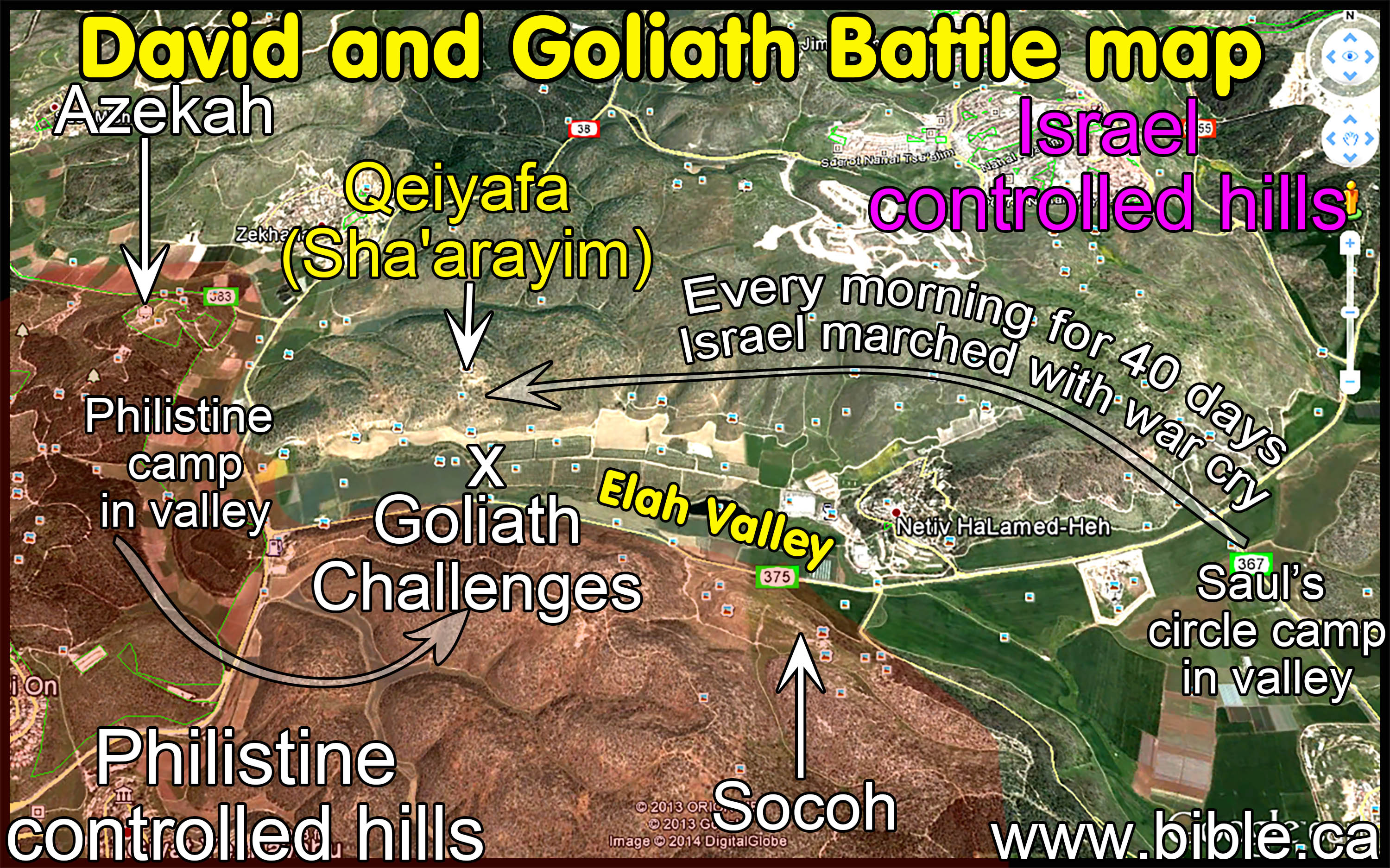
a.
David selected 5 round river stones either the size of tennis balls or ping
pong balls. Both sizes have been excavated at Khirbet El-Maqatir. Notice the
dark flint grain in the picture below. If you smash these hard against another
flint or with iron, they shatter and create very sharp surgical grade knives.
It is this kind of flint that would be used in arrows for war.

b.
Pictured below is an authentic shepherds sling (modern reproduction) and
ping pong size flint nodule sling stones excavated in Israel:
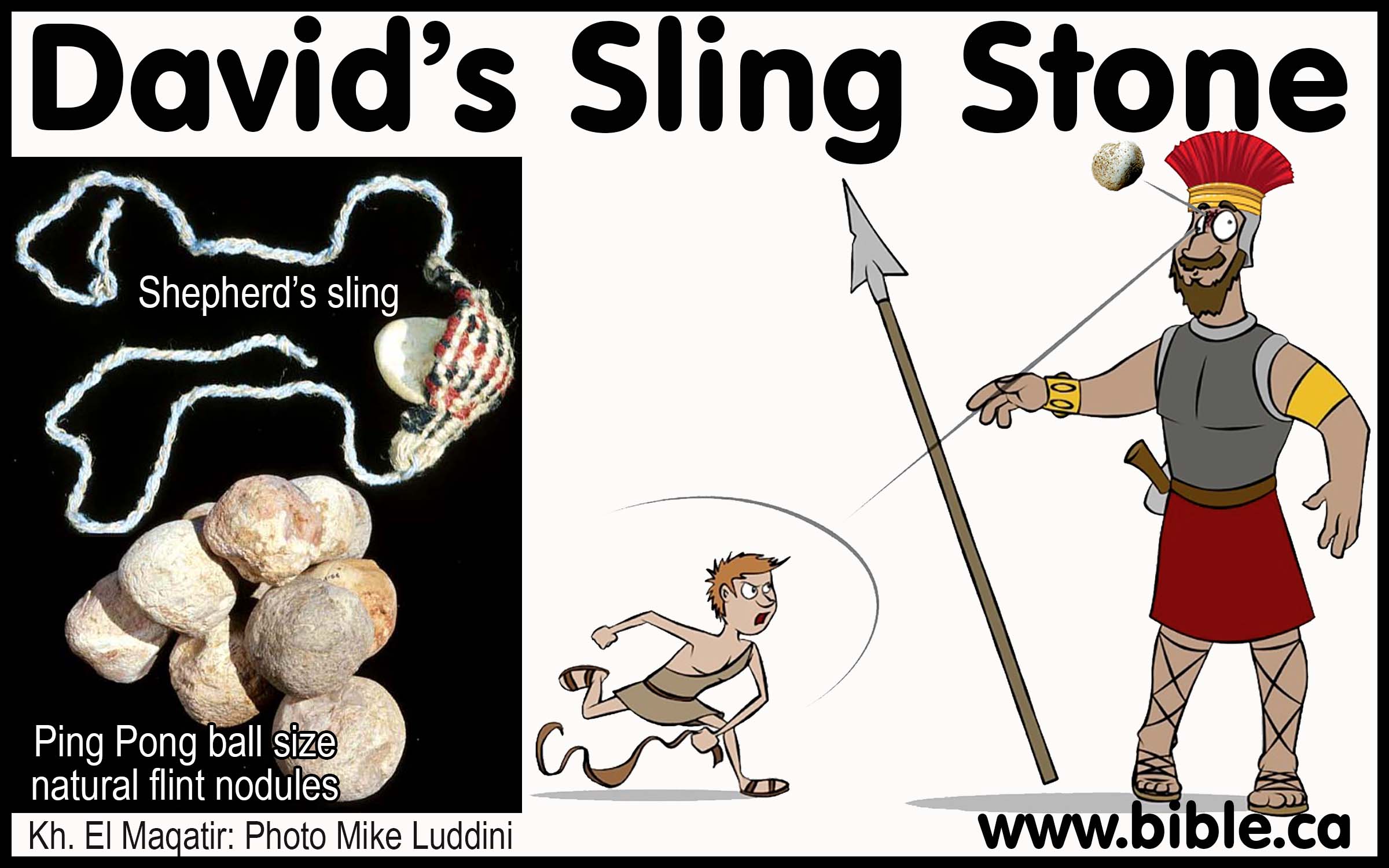
c. The sling stones of the late bronze and Iron ages were the size of tennis balls and were generally flint nodules that where gently chipped to enhance and perfect their already almost circular natural form.
d. Sometimes common limestone fieldstones would be selected because they are round and used as is or be chipped to improve their roundness.
e. Pictured below are 100 flint nodule sling stones used in war the size of tennis balls excavated by the author at Kh. Maqatair (Biblical Ai of Joshua, Ephraim of Jesus in John 11)
B. Many of the Philistines had defected to David and become his allies: 2 Samuel 8:18; 1 Kings 1:38
1. It is interesting to note that when David was fleeing from Saul, that David became the army commander of the king of Gath who called David, “his angel” (1 Samuel 29:9). These friendly relations may date back to a covenant Isaac made with the Philistine king of Gerar. David had many trusted Philistines in his command network.
2. The first mention of the Cherethites, is when the Amelekites raided them in the Negev and David at Ziglag. At this early time the Cherethites where loyal to David: “We made a raid on the Negev of the Cherethites, and on that which belongs to Judah, and on the Negev of Caleb, and we burned Ziklag with fire.” (1 Samuel 30:14)
3. David had three sects of the "Sea Peoples" defect and join his forces, perhaps as mercenaries, but also more likely that they saw the virtue and power of David and that God was with him:
a. “Benaiah the son of Jehoiada was over the Cherethites and the Pelethites; and David’s sons were chief ministers.” (2 Samuel 8:18)
b. “Now all his servants passed on beside him, all the Cherethites, all the Pelethites and all the Gittites, six hundred men who had come with him from Gath, passed on before the king. Then the king said to Ittai the Gittite, “Why will you also go with us? Return and remain with the king, for you are a foreigner and also an exile; return to your own place. “You came only yesterday, and shall I today make you wander with us, while I go where I will? Return and take back your brothers; mercy and truth be with you.” But Ittai answered the king and said, “As the LORD lives, and as my lord the king lives, surely wherever my lord the king may be, whether for death or for life, there also your servant will be.” Therefore David said to Ittai, “Go and pass over.” So Ittai the Gittite passed over with all his men and all the little ones who were with him.” (2 Samuel 15:18–22)
c. “David sent the people out, one third under the command of Joab, one third under the command of Abishai the son of Zeruiah, Joab’s brother, and one third under the command of Ittai the Gittite. And the king said to the people, “I myself will surely go out with you also.”” (2 Samuel 18:2)
d. “So Joab’s men went out after him, along with the Cherethites and the Pelethites and all the mighty men; and they went out from Jerusalem to pursue Sheba the son of Bichri.” (2 Samuel 20:7)
e. “So Zadok the priest, Nathan the prophet, Benaiah the son of Jehoiada, the Cherethites, and the Pelethites went down and had Solomon ride on King David’s mule, and brought him to Gihon.” (1 Kings 1:38)
f. “The king has also sent with him Zadok the priest, Nathan the prophet, Benaiah the son of Jehoiada, the Cherethites, and the Pelethites; and they have made him ride on the king’s mule.” (1 Kings 1:44)
4. The Cherethites and the Pelethites are never mentioned again after the coronation of Solomon.
5. God prophesied through Jeremiah 47:4 and Amos 9:7 (see above) that the Philistines would go into extinction.
a. “Behold, I will stretch out My hand against the Philistines, even cut off the Cherethites and destroy the remnant of the seacoast.” (Ezekiel 25:16)
b. “For Gaza will be abandoned And Ashkelon a desolation; Ashdod will be driven out at noon And Ekron will be uprooted. Woe to the inhabitants of the seacoast, The nation of the Cherethites! The word of the LORD is against you, O Canaan, land of the Philistines; And I will destroy you So that there will be no inhabitant. So the seacoast will be pastures, With caves for shepherds and folds for flocks. And the coast will be For the remnant of the house of Judah, They will pasture on it. In the houses of Ashkelon they will lie down at evening; For the LORD their God will care for them And restore their fortune.” (Zephaniah 2:4–7)

VI. Philistine and Libyan Prisoners of War:
1. Rameses III (1184-1153 BC) capture Philistine prisoners of war: 1177 BC
a. From a large stone wall relief in the Medinet Habu in Thebes, in the 8th year, there are relief of Philistines with elbows tied together so as to dislocate the joins.
b. The later Assyrians and Babylonians (850-600 BC) would put a fishhook through the nose or lip and tie a string connecting everyone.
2. Rameses III capture Libyan prisoners of war: 1180 BC
a. In the 5th year of Rameses III’s reign (1180 BC) he defeated the Libyans. From a large stone wall relief in the Medinet Habu in Thebes, the Libyans are killed and their hands are severed and thrown into victory heaps.
b.
Another scene shows how Libyans are captured and bound by dislocated
their shoulders. The Egyptians tied the elbows together to they touched in
three ways: behind back, over the head and in front. Each way dislocated the
shoulders and caused incredible pain. This would disable him in war if he
escaped, but it would heal in a few months so he could be sold as a slave. They
were also connected with ropes. Notice the tattoos on the arms of the Libyans
that were forbidden by the Law of Moses (Lev 19:28).
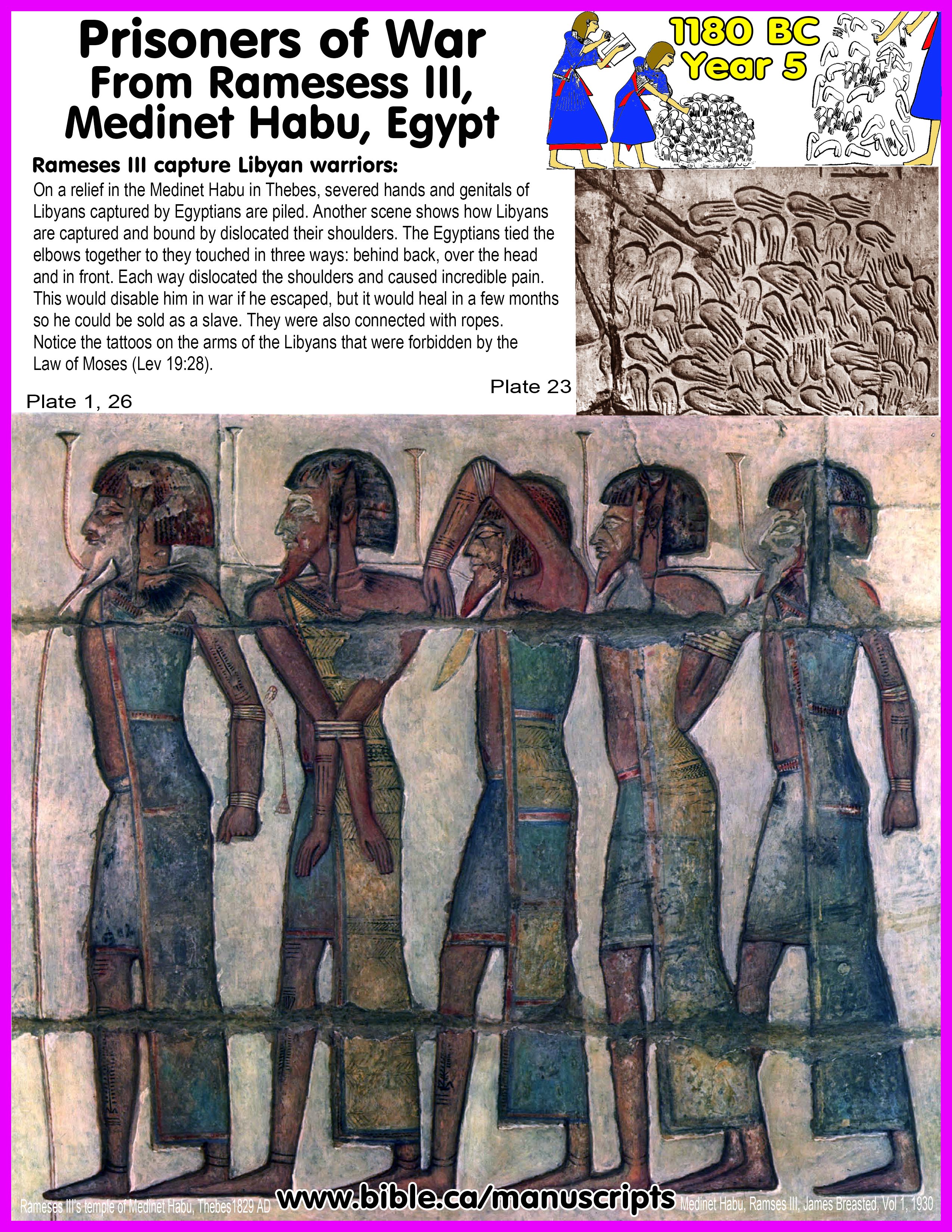

VII. Philistine war gear: Feathered and horned helmets, spears and shields: 1177 BC
A. The large stone wall relief in the Medinet Habu in Thebes, in the 8th year, shows the two different kinds of Philistine helmets.
1.
Here are stone carvings of the classic “feather” Philistine helmit as
well as the “horned” Philistine helmets.
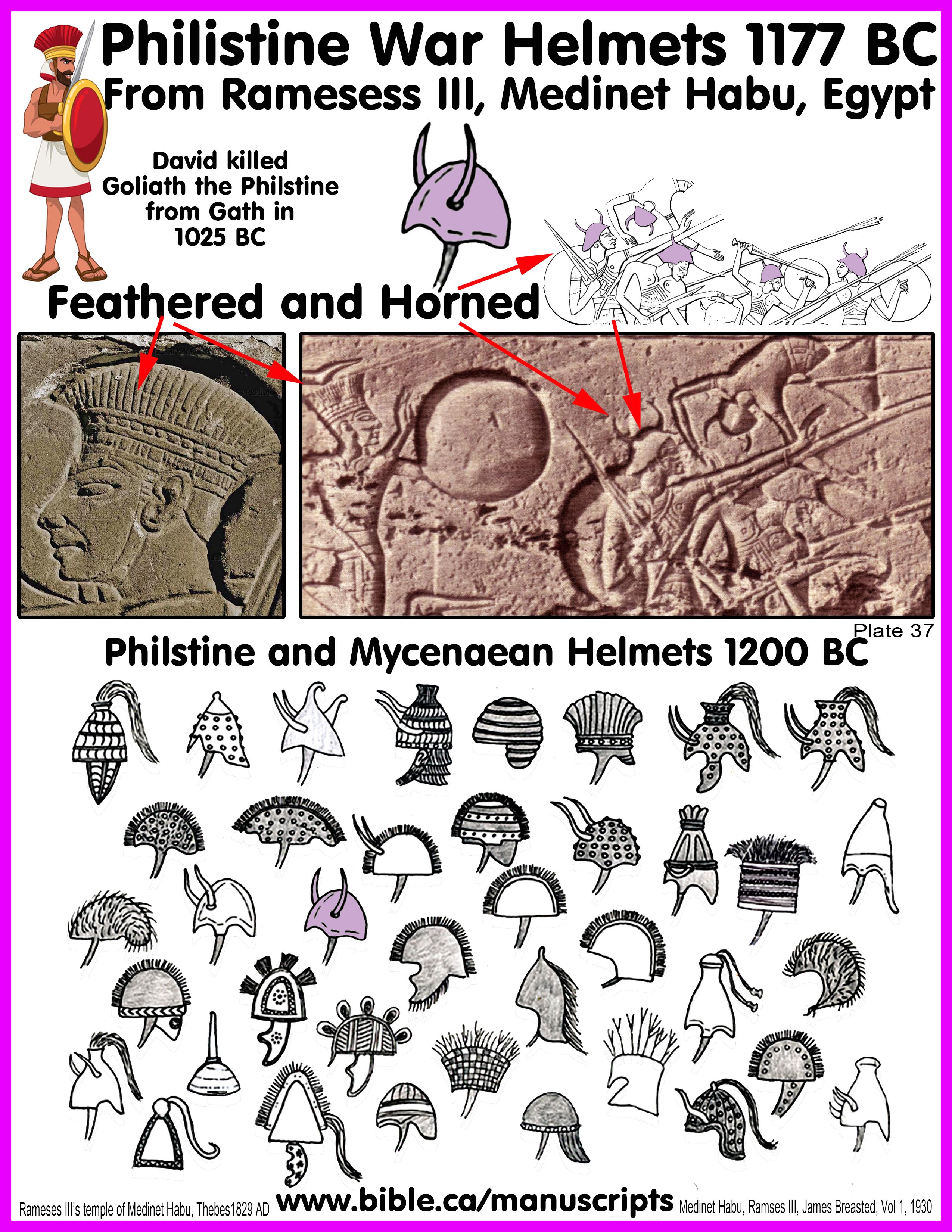

VIII. Philistines trigger collapse of Bronze Age and mark beginning of Iron age: 1177 BC
A. Discussion about the Iron age starting in 1177 BC:
1. Note: “Iron Age” is identified not merely by the use of iron, but also ceramic pottery types, language scripts, artwork and building construction differences.
2. The Archeological Bronze Age changed to the Iron age in Canaan because of the Philistines conquered the Asia and the Levant in 1177 BC.
a. The records of Rameses III document a great world uprising of the Philistines and describes them as unstoppable in his 8th regnal year (1177 BC)
3. Philistine pottery:
a. The trademark “Philistine pottery” with its swirls, spirals and cross-hatch design found at Gath and other Philistine sites emerged in Judea in 1177 BC.
b. Around 1200 BC monochrome Philistine pottery gradually over 100 years expanded to include bichrome forms around 1100 BC.
c. Philistine monochrome pottery dates to 1200-1100 BC
d. Philistine bichrome pottery dates to 1100 – 1000 BC
4. Iron was in use throughout Canaan at the time of Moses and Joshua, which is 250 before the “Iron age” began.
a. Moses warned not to use iron in shaping stones for Jewish altars.
i. “Moreover, you shall build there an altar to the Lord your God, an altar of stones; you shall not wield an iron tool on them." (Deuteronomy 27:5)
b. In 1406 BC the philistines possessed iron chariots at the time of Joshua in Canaan.
i. "And Judah took Gaza with its territory and Ashkelon with its territory and Ekron with its territory. Now the Lord was with Judah, and they took possession of the hill country; but they could not drive out the inhabitants of the valley because they had iron chariots." (Judges 1:18-19)
c. The king of Og was a giant with a 17-foot-long iron bed.
i. "For only Og king of Bashan was left of the remnant of the Rephaim. Behold, his bedstead was an iron bedstead; it is in Rabbah of the sons of Ammon. Its length was nine cubits and its width four cubits by ordinary cubit." (Deuteronomy 3:11)
d. The iron from the conquest of Jericho was to be put into the public treasury.
i. Jericho: “But all the silver and gold and articles of bronze and iron are holy to the Lord; they shall go into the treasury of the Lord.” (Joshua 6:19, 24)
e. The iron from the conquest of the trans-Jordan was distributed among the Israelites to use freely.
i. "Joshua said to them (trans-Jordan tribes), “Return to your tents with great riches and with very much livestock, with silver, gold, bronze, iron, and with very many clothes; divide the spoil of your enemies with your brothers.”" (Joshua 22:8)
f. In 1200 BC, Deborah defeated Sisera who had 900 iron chariots
i. "Sisera called together all his chariots, nine hundred iron chariots, and all the people who were with him, from Harosheth-hagoyim to the river Kishon." (Judges 4:13)
g. Goliath’s spear was made of iron:
i. "The shaft of his spear was like a weaver’s beam, and the head of his spear weighed six hundred shekels of iron; his shield-carrier also walked before him." (1 Samuel 17:7)
5. At the time of Saul (1052 BC), the Philistines had succeeded in controlling all the Iron among the Hebrews.
a. "Now no blacksmith could be found in all the land of Israel, for the Philistines said, “Otherwise the Hebrews will make swords or spears.” So all Israel went down to the Philistines, each to sharpen his plowshare, his mattock, his axe, and his hoe. The charge was two-thirds of a shekel for the plowshares, the mattocks, the forks, and the axes, and to fix the hoes. So it came about on the day of battle that neither sword nor spear was found in the hands of any of the people who were with Saul and Jonathan, but they were found with Saul and his son Jonathan." (1 Samuel 13:19–22)
b. 1 Samuel 13:19 dates 130 years AFTER the “Iron age began” in 1177 BC.
c. It clearly represents a specific moment in Israel’s history where they were oppressed because they were already in possession of Iron the previous century.
B. The Archeologist’s problem of the Philistine Pentapolis in 1446 BC:
1. Most conservative Bible believing archeologists explain the Philistine Pentapolis described in scripture before 1177 BC as an anachronism.
2. As the story goes, from the time of Joshua’s death in 1356 BC to the supposed “first arrival” of the Philistines in 1177 BC is only 180 years, but we know that story is wrong.
3. The Bible makes it clear that the Philistine Pentapolis was in existence at the time of Moses and Joshua: Josh 13:1-3; Judges 3:1-3.
4. The transition between the Late Bronze age and the Iron age is set at 1177 BC BECAUSE that is when the Philistines are believed to first occupy the coastal regions of Canaan and the five cities of the Philistine Pentapolis.
a. We are certain that there was a major uprising of the Philistines who essentially conquered the world nations bordering on the Mediterranean Sea from Asia down to Egypt around 1177 BC based upon extant inscriptions of Rameses III.
b. There were in fact sufficient cultural and ceramic changes to warrant the Iron Age beginning in 1177 BC in spite of the fact that the Philistines had continuously occupied their Pentapolis of 5 city states from the time of Moses.
5. It is the massive influx of new and culturally distinct Philistines in 1177 BC who moved in with their fellow Philistines who caused the cultural revolution that triggered the collapse of the Late Bronze age and the beginning of the Iron IA age.
C. Philistine Pentapolis in 1446 is not anachronistic (Ex 13:17-18 and Josh 13:1-3 and Judges 3:1-3)
1. If Philistines did not occupy the five coastal cities of their Pentapolis, why did God say to Moses he would NOT, “by the way of the land of the Philistines, even though it was near” (Exodus 13:17–18)
a. Comment: To make this into an anachronism added by a later editor and adopted into our bible begs the question. It also creates a fictitious, phantom enemy of the Philistines when the truth is it was another entirely different people called the Canaanites etc. Further, the supposed editor could have simply said “the Way of Horus” or the costal highway and the point would have been equally valid. Adding “Philistine” doesn’t add any new detail… it creates an historic error for Bible trashers to jump on!
2. If Philistines did not occupy the five coastal cities of their Pentapolis, why is there a specific mention of the Philistines as those “nations” that remained after the death of Joshua:
a. Comment: There is zero value in a latter editor adding the anachronistic “Philistines” as one of the nations NOT driven out by the Hebrews at the time of Joshua. It creates an historic error. It is argued that it assisted in locating the geography of WHERE Israel failed to drive out the Canaanites. Yet the cities themselves are named as well know locatives making it is unnecessary to add “Philistines” since these cities were all ancient, long predating the exodus itself in 1446 BC. This is not an anachronism because is creates an historic fiction of Philistines in the land which do not assist in providing a locative superior than the city names alone.
b. "Now Joshua was old and advanced in years when the Lord said to him, “You are old and advanced in years, and very much of the land remains to be possessed. “This is the land that remains: all the regions of the Philistines and all those of the Geshurites; from the Shihor which is east of Egypt, even as far as the border of Ekron to the north (it is counted as Canaanite); the five lords of the Philistines: the Gazite, the Ashdodite, the Ashkelonite, the Gittite, the Ekronite; and the Avvite" (Joshua 13:1–3)
c. "Now these are the nations which the Lord left, to test Israel by them (that is, all who had not experienced any of the wars of Canaan; only in order that the generations of the sons of Israel might be taught war, those who had not experienced it formerly). These nations are: the five lords of the Philistines and all the Canaanites and the Sidonians and the Hivites who lived in Mount Lebanon, from Mount Baal-hermon as far as Lebo-hamath." (Judges 3:1–3)
3. If the Philistines occupied the five coastal cities of their Pentapolis, why are they not listed as one of the seven nations living in Canaan whom Joshua was defeat?
a. “This is the land that remains: all the regions of the Philistines and all those of the Geshurites; from the Shihor which is east of Egypt, even as far as the border of Ekron to the north (it is counted as Canaanite); the five lords of the Philistines: the Gazite, the Ashdodite, the Ashkelonite, the Gittite, the Ekronite" (Joshua 13:1-3)
b. ANSWER: Notice the statement that the Philistine controlled lands are “counted as Canaanite”. In other words, the Philistines are referred to as the more generic “Canaanites”. Therefore, the Canaanites included the Philistines. In Joshua 10:5, the King of Jerusalem was an Amorites, yet we know that the Jebusites occupied Jerusalem. This may be because the Amorites were a ruling foreign class that governed the Jebusite people. Yet we know that the term Amorite is applied to a wide range of peoples so that it almost becomes a synonym similar to the generic “Gentile”.
4. Why does Joshua in Judges 1:18-19 name several Philistine Pentapolis cities being captured without naming the Philistines?
a. ANSWER: Notice the capture of these cities was hampered by iron chariots in the cities next to the coast. This is historically accurate and was the reason why the faithless tribe of Dan gave up on their allotted inheritance and opted to move north to Laish (Tel Dan). So, the Philistine Pentapolis cities were a strong undefeatable force at the time of Joshua, except by faith.
5. Why does the book of Judges not record any oppression by the Philistines or defeat of the Philistines until after the death of Deborah in 1200 BC, when Shamgar first engaged the Philistines?
a. ANSWER: The Philistines never tried to control, oppress or extract tribute from the Hebrews. They co-existed as two separate nations. The first three judges liberated the Hebrews from the outside oppression of the area wherein they lived and occupied in the hill country.
6. Why does Judges 3:5-6 not list the Philistines?
a. "The sons of Israel lived among the Canaanites, the Hittites, the Amorites, the Perizzites, the Hivites, and the Jebusites; and they took their daughters for themselves as wives, and gave their own daughters to their sons, and served their gods." (Judges 3:5-6)
d. ANSWER: Notice that the Hebrews and Philistines lived in distinct geographical areas. The Philistines occupied the coastal plain and the other nations LIVED AMONG the Hebrews in the hill country in inside their cities.
6. It is clear that these references to Philistines at the time of Moses and Joshua are not anachronistic but represent a real occupation by the Philistines from 1446 BC down to the time of David.
D. Anachronism and prolepsis does occur in the Bible:
1. Some argue that since we are certain that Anachronism and prolepsis does occur in the Bible in some places, therefore the references to Philistines in Canaan before 1177 BC in the Pentateuch and Joshua can also be proleptic.
a. While this is reasonable, it does not need to be the case because it actually creates contradictions in scripture, history and archeology.
b. Comment: The problem with Philistine being proleptic, is that it invents a fictitious enemy which is factually and historically inaccurate and there is no need to change “Canaanite” (or whatever) to the technically incorrect “Philistine” since the locations of the five named cities was well understood. There are other examples of proleptic references.
2. Here is a discussion of all known Anachronisms in the Pentateuch and Joshua and Judges:
a. All the accepted and known examples of prolepsis are simple updated name changes of cities.
b. Suggesting that Philistines occupied five cities on the coast inside Canaan as a cause of fear for the Exodus Hebrews to return to Goshen goes way beyond a mere update of a city name. It creates an historic fiction!
c. While there are clear examples of someone changing or updating the text of the Pentateuch, the references to the Philistine Pentapolis as anachronism create contradiction, are counterproductive and do not provide any new clarity for later readers.
|
Prolepsis or Anachronism in the Bible |
|
|
Original name when stories happened |
Later proleptic/anachronistic name used in in the narration of earlier stories before the name existed at that time |
|
Philistines at the time of Joshua: In Josh 13:1-3 etc, references to the “five lords of the Philistines: the Gazite, the Ashdodite, the Ashkelonite, the Gittite, the Ekronite” are later parenthetical insertions to explain the location of the area being described. |
The cities themselves are named as locatives, it is unnecessary to add “Philistines” since these cities were all ancient, long predating the exodus itself in 1446 BC. This is not an anachronism because it creates an historic fiction of Philistines in the land which do not assist in providing a locative superior than the city names alone. |
|
Luz: Renamed "Bethel" by Jacob in Gen 28:19 between 2006 -1886 BC |
Bethel used 4 times: Genesis 12:8; 13:3. Here we have an example of Moses updating the name before the renaming took place. This shows that the Holy Spirit will employ anachronisms by Moses himself! |
|
Laish, Leshem: Renamed "Dan" by Tribe of Dan in 1304 BC in Judges 18:29; Josh 19:47 |
Dan used 2 times: Gen 14:14; Deut 34:1. Dan did not move north to Laish until after 1340 BC, long after both Moses AND Joshua where dead. Someone after Moses died updated the name. |
|
Unknown original name: Genesis 13:10-11 and 50 additional times |
Jordan River: The tribe of Dan migrated north to Laish in 1340 BC (Judges 18-19). Jordan means literally, “down from Dan”, ie Laish was the headwaters of Tel-Dan and therefore the river flowed “down” from the “tribe of Dan” at Laish. Someone after Moses died updated the name. |
|
Zephath: Renamed Hormah by the tribes of Judah and Simeon in 1399 BC in Judges 1:17 |
Hormah used 5 times in Num 14:45; Deut 1:44; Josh 12:14; 15:30: 19:4. Someone after Moses died updated the name. |
|
Mamre, Kiriath-Arba: Renamed Hebron possibly in 1094 BC, 7 years before Zoan was built in Egypt in 1087 BC. However, there is evidence and it is more likely that Zoan had been founded much earlier since Psalm 78:43 says that Zoan existed at the time of the Exodus in 1446 BC. But the Ps. Reference itself may be a proleptic name for Goshen since at the time of David and Ps 78, Zoan was the name used for the region of the eastern delta. The reference to Zoan in Num 13:22, on the other hand, may be a later editorial update. |
Hebron used 15 times in Genesis, Joshua and Judges: Gen 13:18; 23:19; 37:14; Num 13:22; Josh 10:3,5,23,36,39; 11:21; 12:10; 14:13; 21:13; Judges 1:20. Someone after Moses died updated the name. |
|
Ur: Gen 11:28, 31; 15:7: The town in Mesopotamia from which Abraham came to the Promised Land is called “Ur of the Chaldeans” |
Of the Chaldeans: “Linguistic Evidence. “Chaldeans” (note the l) is a later spelling than the Genesis Kasdîm (note the s). Akkadian scholars have long recognized a peculiarity of the Akkadian language: the phenomenon of a phonetic shift of the sibilant (s) to a lamed when the sibilant is followed by a dental (d). The shift (s to l) appeared in the second millennium B.C. and continued until the Neo-Babylonian era (ca. 600- 550 B.C.).18 This places the phenomenon at least as early as Middle Babylonian (1500-1000 B.C.).19 That means that the form in a Moses-authored Genesis (ca. 1400 B.C.) falls within the range of time that Kasdîm occurs. Therefore, the linguistic shift cannot be employed to deny Mosaic authorship and argue for some form of textual updating. … Thus, we come to the conclusion that the Chaldeans are more ancient than the Assyrian records. A more reasonable approach to the mention of Chaldeans in the patriarchal narratives would be to accept the biblical references as original, since the available cuneiform records are admittedly fragmentary and incomplete…. In seeking a resolution to the problem presented by the mention of the Chaldeans in the patriarchal narratives, we must realize that “commitment to inerrancy, even in its broader terms, doubtless requires faith in the future resolution of a number of problems in Scripture, through a deeper penetration of the text itself and of the realities to which it refers.” Therefore, I prefer the stance of Kelso, with which this paper began. I prefer to wait for the Chaldeans to actually turn up in some cuneiform document that is either contemporary with the biblical patriarchs or at least pre-Mosaic. Until that time, I prefer to accept the Scriptural account as original and accurate, without resorting to anachronism or textual updating.” (“UR OF THE CHALDEANS” Gen 11:28-31: A Model for Dealing with difficult texts, William D. Barrick, 2009 AD) This is not an anachronism because Moses correctly recorded that the Chaldeans (Moses used the correct term for the period: “Kasdîm”) date back to the time of Abraham. |
|
Land of, city of Rameses 1870 BC: "So Joseph settled his father and his brothers and gave them a possession in the land of Egypt, in the best of the land, in the land of Rameses, as Pharaoh had ordered." (Genesis 47:11) 1446 BC: "So they appointed taskmasters over them to afflict them with hard labor. And they built for Pharaoh storage cities, Pithom and Raamses." (Exodus 1:11, MT) The LXX adds: “so they constructed fortified cities for Pharaoh, both Pithom, Rameses, and On, which is Heliopolis.” |
Rameses: This is viewed by most as an anachronism added by a later editor because the Ramesside dynasty from archeology did not predate the 13th century BC. Notice that the Hebrews settled in the “land of Rameses” whe they arrived in 1870 BC and built the city of Rameses the year they left in 1446 BC. This is not an anachronism because one day they may discover that the land of Goshen was called the Land of Rameses at the time of Joseph. It may very well be that Rameses I took on the name BECAUSE of its ancient tradition that dates back to the 19th century BC. |
E. Moses didn’t write the Pentateuch and the later writer added the anachronisms?
1. The fact that Judges was written after the Assyrian Captivity of 723 AD doesn’t mean that the author would add the Philistines into the story of the conquest via anachronism or change the fact that Moses did write the Pentateuch!
2. There are some direct indications Moses did not every word in the first five books of the Bible, most notably Deut 34 which describes events AFTER Moses’ death.
a. But his does not mean that additional text is an uninspired gloss.
b. Both Deut. and Joshua were updated after Moses and Joshua’s death.
c. It is likely this inspired writer who appended both books at the same time.
d. This accounts for the other clearly anachronistic statements in the Bible about the Jordan and the tribe of Dan etc. in 1340 BC.
e. So even a date of 1340 BC accounts for 100% of the known or suggested anachronisms in these books.
3. We are certain that Moses wrote the “book of the Law”:
a. Keep in mind, however, that Moses wrote the “book of the law” which was placed on the side of the Ark of the Covenant, while the Ten Commandments (written by God) were placed inside the Ark. "Then He commissioned Joshua the son of Nun, and said, “Be strong and courageous, for you shall bring the sons of Israel into the land which I swore to them, and I will be with you.” It came about, when Moses finished writing the words of this law in a book until they were complete, that Moses commanded the Levites who carried the ark of the covenant of the LORD, saying, “Take this book of the law and place it beside the ark of the covenant of the LORD your God, that it may remain there as a witness against you." (Deuteronomy 31:23-26)
b. This book of the law was written just before Moses died in 1406 BC and was written in the hieroglyphic Hebrew script that predated Paleo-Hebrew.
c. It is possible that Genesis – Deut were written after Moses died but embedded with the Pentateuch, the entire “Mosaic book of the Law” given to Joshua, inside the 5 books.
4. Moses is attributed by all other authors and Jesus himself as writing Genesis – Deut:
a. The classic statement by Jesus proves that Moses wrote messianic passages about Jesus: (Gen 3; 12;15; Deut 18:18; Num 24:15-17 etc. "“For if you believed Moses, you would believe Me, for he wrote about Me. “But if you do not believe his writings, how will you believe My words?”" (John 5:46–47).
b. There are many examples of inspired prophets using scribes to record their divine messages from God. Perhaps Moses enlisted the help of a scribe who then wrote the last chapter after he died.
c. The inspired author of Joshua may have appended the last chapter of Deut 24 to the book.
|
Did write the Pentateuch? |
|
|
Problem: |
Solution: |
|
Deut 34 includes events after Moses died |
The additional text was not written by Moses but by another inspired prophet. A date of 1340 BC accounts for all known anachronistic references. |
|
Gen 12:6; 13:7 seem to indicate that the book was written at a later time when the Canaanite was no longer in the land. |
Yet God specifically promised Abraham that he would dispossess 7 nations including the Canaanites etc. in Genesis 15:18-21. So while this phrase “Now in the land” has been the fodder for endless speculation of a later writer other than Moses, it is not really valid at this place at all. Agreed, it could indicate a later writer, but this is cautioned with a reasonable and logical explanation. 1. "Abram passed through the land as far as the site of Shechem, to the oak of Moreh. Now the Canaanite was then in the land." (Genesis 12:6) 2. "And there was strife between the herdsmen of Abram’s livestock and the herdsmen of Lot’s livestock. Now the Canaanite and the Perizzite were dwelling then in the land." (Genesis 13:7) |
|
"Now the man Moses was very humble, more than any man who was on the face of the earth." (Numbers 12:3) Humble Moses would not write this about himself. Humble men do not brag about their humility! |
Moses wrote under inspiration and it may have been a way to provide not only a compliment to Moses from the Holy Spirit but to highlight Moses as an example to follow. Jesus said of Himself: “Take My yoke upon you and learn from Me, for I am gentle and humble in heart, and you will find rest for your souls." (Matthew 11:29) |
|
Gen 36:31 begins to list the kings of Edom “before there was a king in Israel”. Saul became king in 1052 BC indicating Genesis was written after Israel’s first king. |
However, God promised several of the patriarchs that their ancestors would be kings in Genesis 17:6,16. Therefore this is not a certain example of Prolepsis. 1. "“I have made you (Abraham) exceedingly fruitful, and I will make nations of you, and kings will come forth from you." (Genesis 17:6) 2. "“I will bless her (Sarah), and indeed I will give you a son by her. Then I will bless her, and she shall be a mother of nations; kings of peoples will come from her.”" (Genesis 17:16) |
3. Analysis of the two solutions above:
a. Moses wrote the Pentateuch.
b. Another inspired prophet appended Deut 24 after Moses died.
c. All known anachronisms can be accounted for by a single person making the updates in 1340 BC.
d. The book of Joshua 24:29-33 also records events after Joshua died. Perhaps the same inspired author appended both Deut and Joshua.
e. Perhaps this same inspired author updated by way of inspired anachronism the references to Dan in Genesis etc.
f. The Philistine occupation of the 5 pentapolis cities at the time of Joshua is historically accurate. Archeologists need to update their understanding to account for this.
g. The Philistines occupied the land of Canaan continuously from the time of Abraham down to the time of king Ahaz (2 Chro 28:18).
4. Conclusion:
a. The power and influence of the Philistines vacillated over time and 1177 BC represents a period in history when they were at their peak.
b. Although the Philistine Pentapolis existed as a kingdom at the time of Joshua, 1177 BC marks and important demarcation point in archeology.
c. With this in mind, 1177 BC is an excellent date to begin the Iron age.

1. Caesar Hadrian renamed Judea “Palestine” which means literally: “Land of the Philistines”
a. Today when you visit Jerusalem and one of the local Arabs insists you call it Palestine not Israel, ask him if he is a decendant of Goliath the Philistine.
b. Today, there is no “land of Palestine” or “Palestinian people” any more than there are Philistines!
c. 99% of these Arabs living in Israel today are migrants from other Muslim nations with no occupational history more than a few dozen years.
d. In AD 1900, almost nobody lived in Canaan/Israel.
e. The Palestinian cause is a lie.
2. The origin of the Philistines is the Island of Crete.
3. The Philistines continued to hold power down to the Babylonian captivity of 605 BC:
a. 1094 BC: "When the five lords of the Philistines saw it, they returned to Ekron that day. These are the golden tumors which the Philistines returned for a guilt offering to the Lord: one for Ashdod, one for Gaza, one for Ashkelon, one for Gath, one for Ekron;" (1 Samuel 6:16–17)
b. 605 BC: "and all the foreign people, all the kings of the land of Uz, all the kings of the land of the Philistines (even Ashkelon, Gaza, Ekron and the remnant of Ashdod);" (Jeremiah 25:20)
c. The Philistines went extinct with the rise of the Babylonian empire.
4. The dawn of the Iron age began in 1177 BC.
5. Archeological excavations at Gath and other Philistine cities:
a. Gath is one of the oldest and continuously occupied Philistine cities in Canaan dating back to the time of Moses. Goliath was descended from the giants (Anakim) from Gath from the time of Joshua. Goliath was one of the giants from Gath descended from the “Anakim” at the time of Joshua: "There were no Anakim left in the land of the sons of Israel; only in Gaza, in Gath, and in Ashdod some remained." (Joshua 11:22)
b. Current excavators at Gath (Tel Safi) like Aren Maeir need to look closely into the dissonance between current archeological dogma that the Philistines first entered Canaan in 1177 BC and the Bible fact that the Philistine Pentapolis of cities, including Gath, were in full operation at the time of the Exodus in the Late Bronze age (1446 BC). This will require shifting their lowest stratum layers with “Philistine Pottery” back at least 300 years into the LB age.
c. Since “Philistine monochrome Pottery” debuted in the 12th century BC, then “older” Stratum layers below previously assigned to Canaanite must be reassigned to Philistine.
d. The material culture excavated in the Late Bronze Stratum levels at the five Philistine pentapolis sites (Gaza, Ashdod, Ashkelon, Gath, Ekron) need to be understood as being Philistine culture.
Quick links within this document:
II. Philistines at the time of Abraham: Gerar in 2075 BC
Philistine feathered helmet on the Phaistos disk from Crete: 1700 BC
III. Philistines Pentapolis at the time of Moses and Joshua: 1446-1356 BC
IV. Philistines at the time of Deborah and Rameses III: 1184-1153 BC
V. Philistines at the time of David: 1025-997 BC
Battle map of David and Goliath in the valley of Elah
Sling Stones used by David to kill Goliath the Philistine
VI. Philistine and Libyan Prisoners of War:
VII. Philistine war gear: Feathered and horned helmets, spears and shields: 1177 BC
VIII. Philistines trigger collapse of Bronze Age and mark beginning of Iron age: 1177 BC
By Steve Rudd. Contact author with comments or questions.

